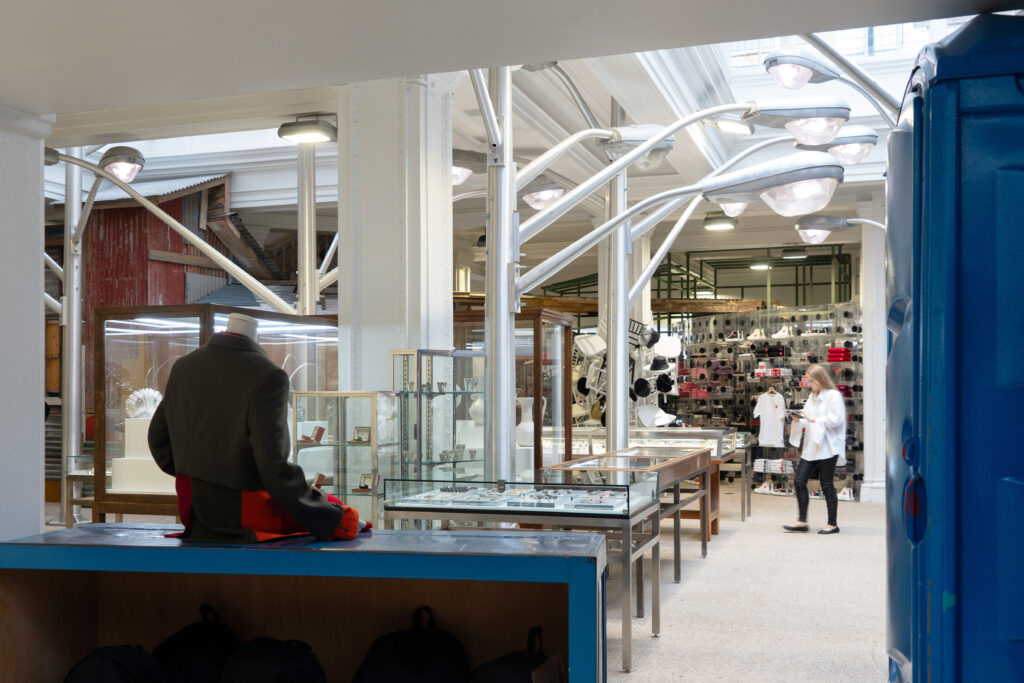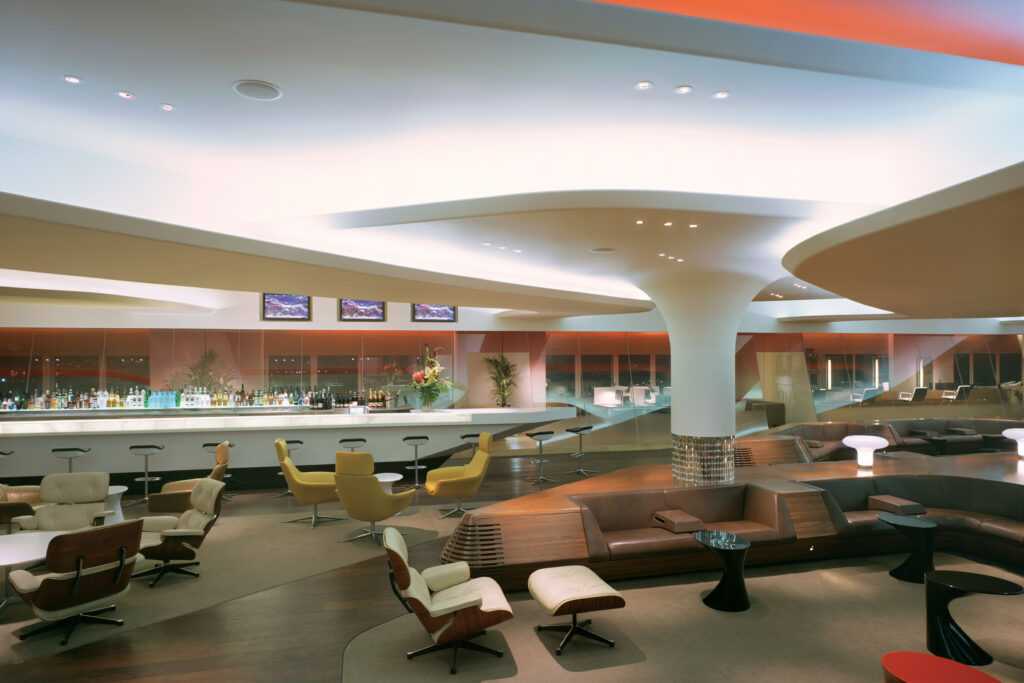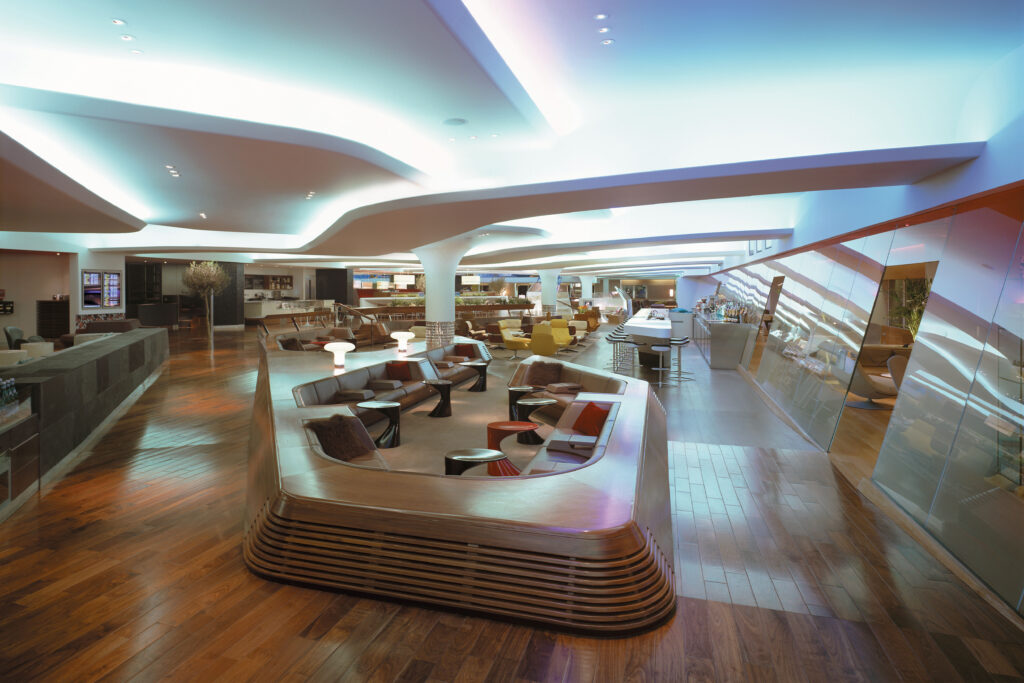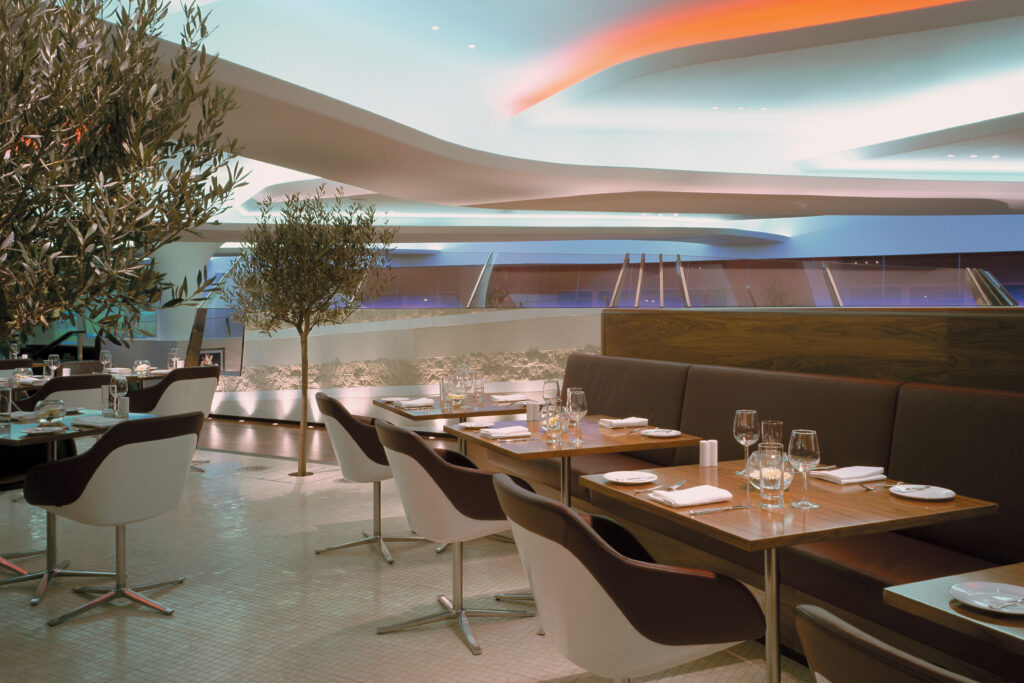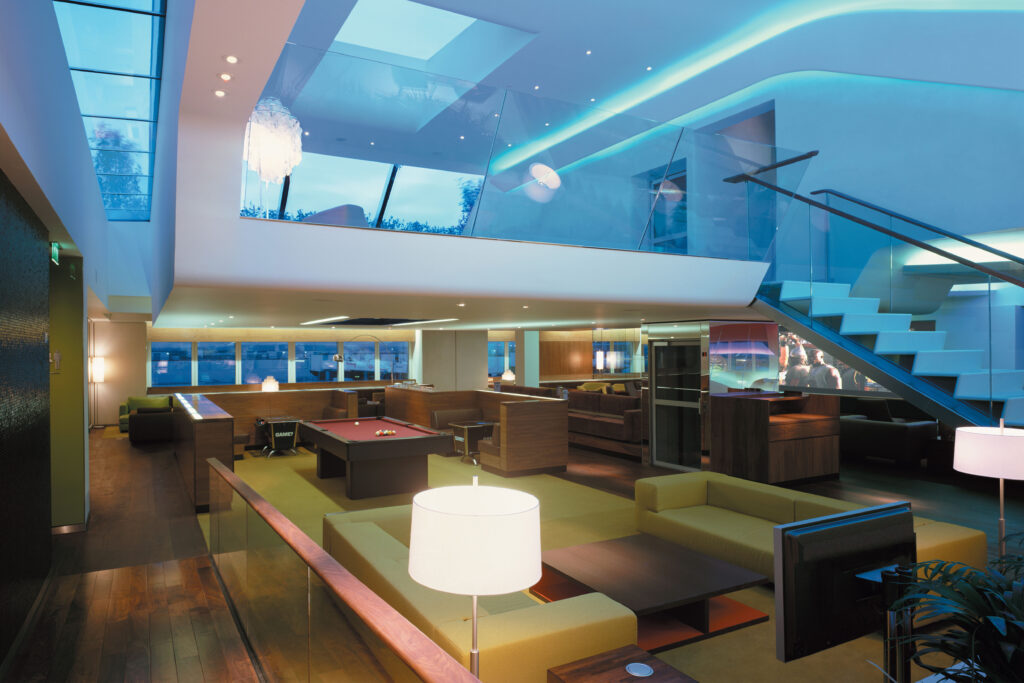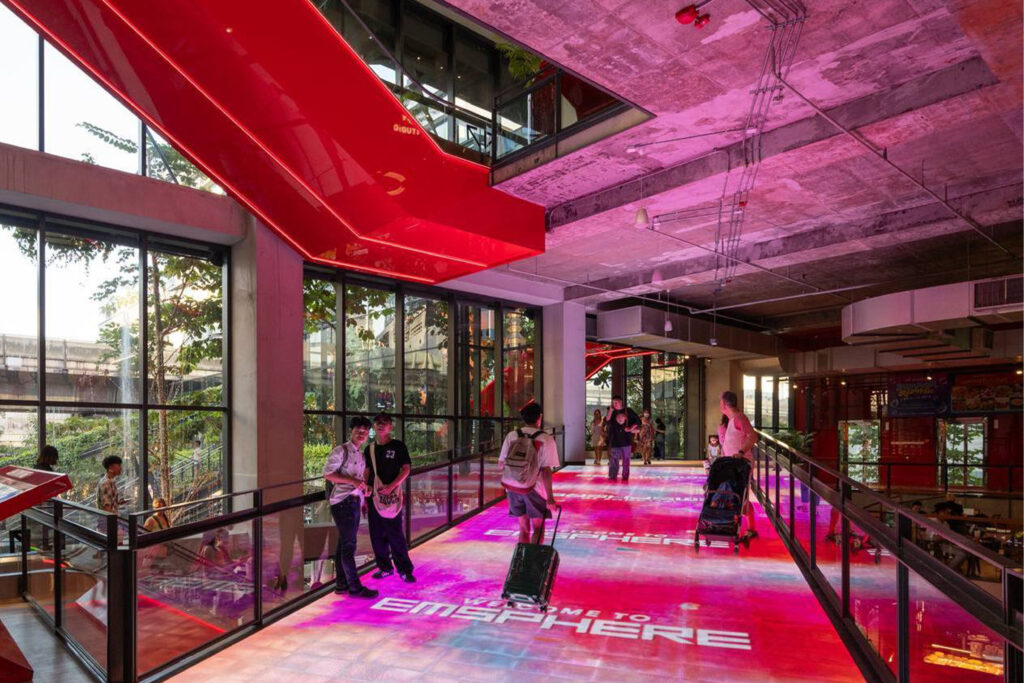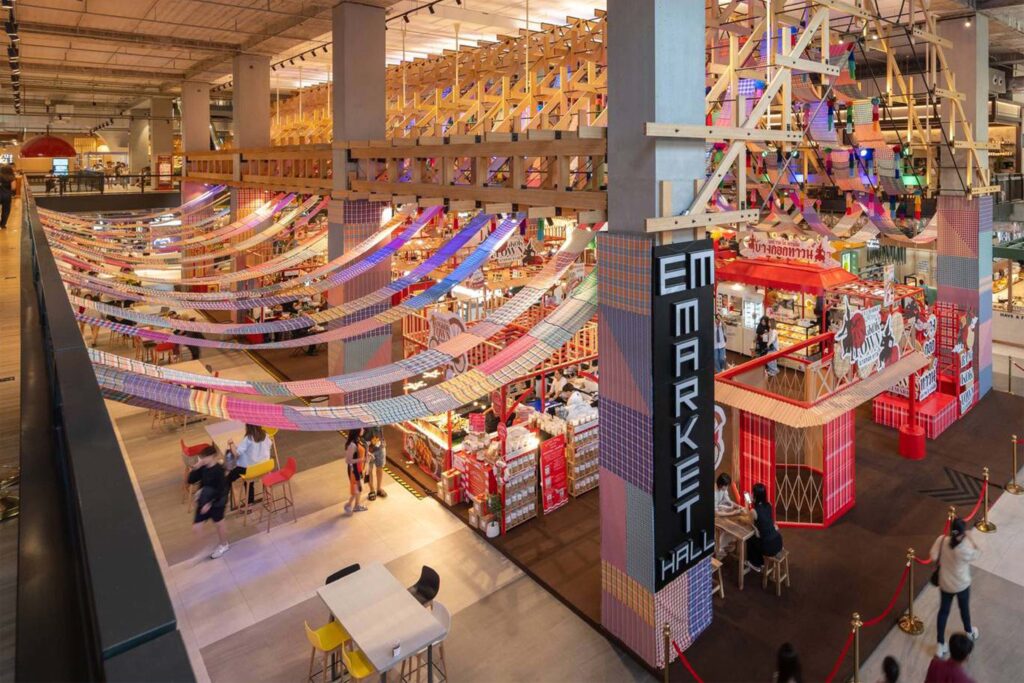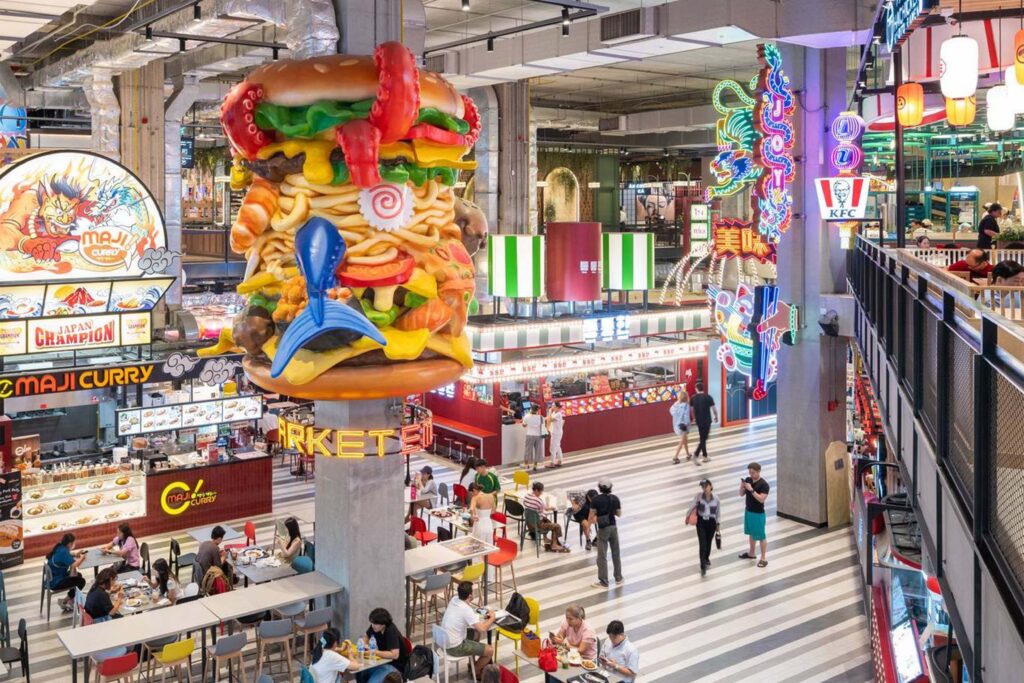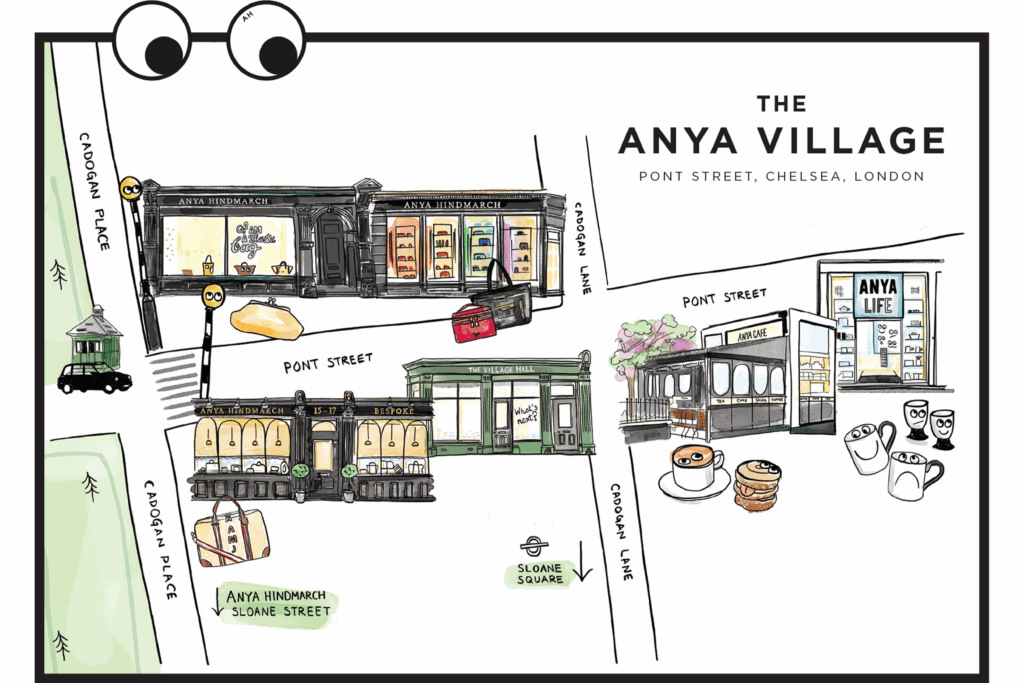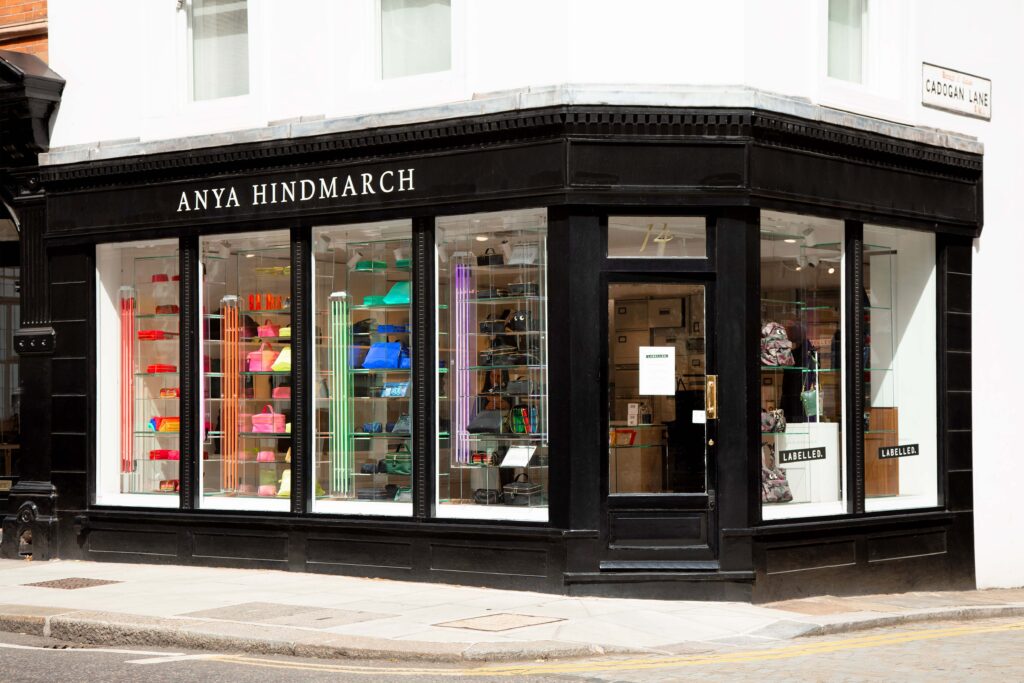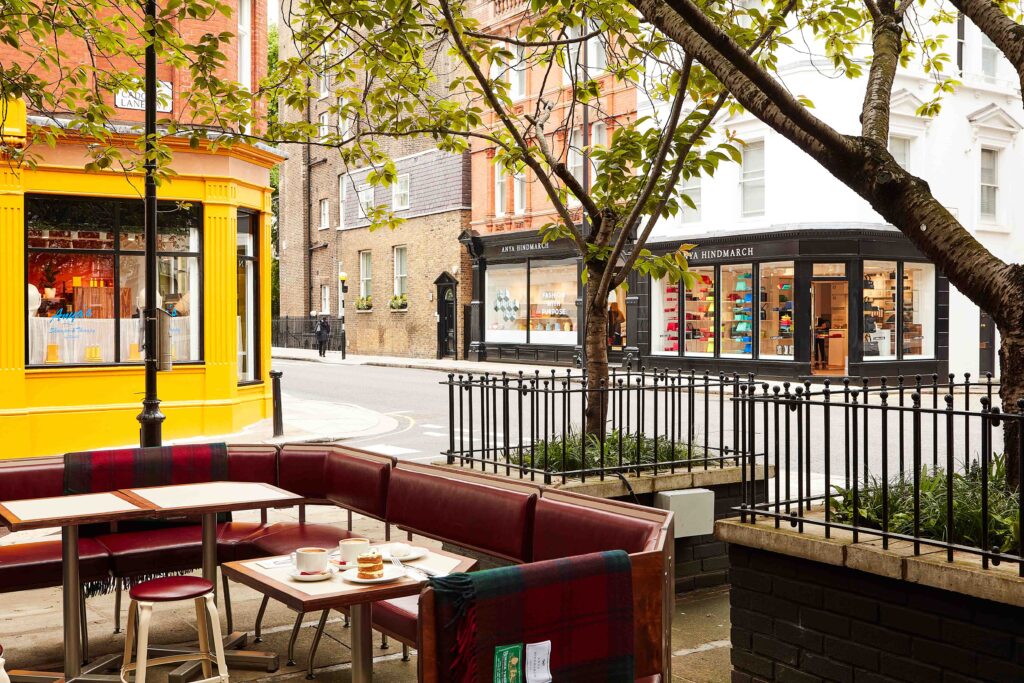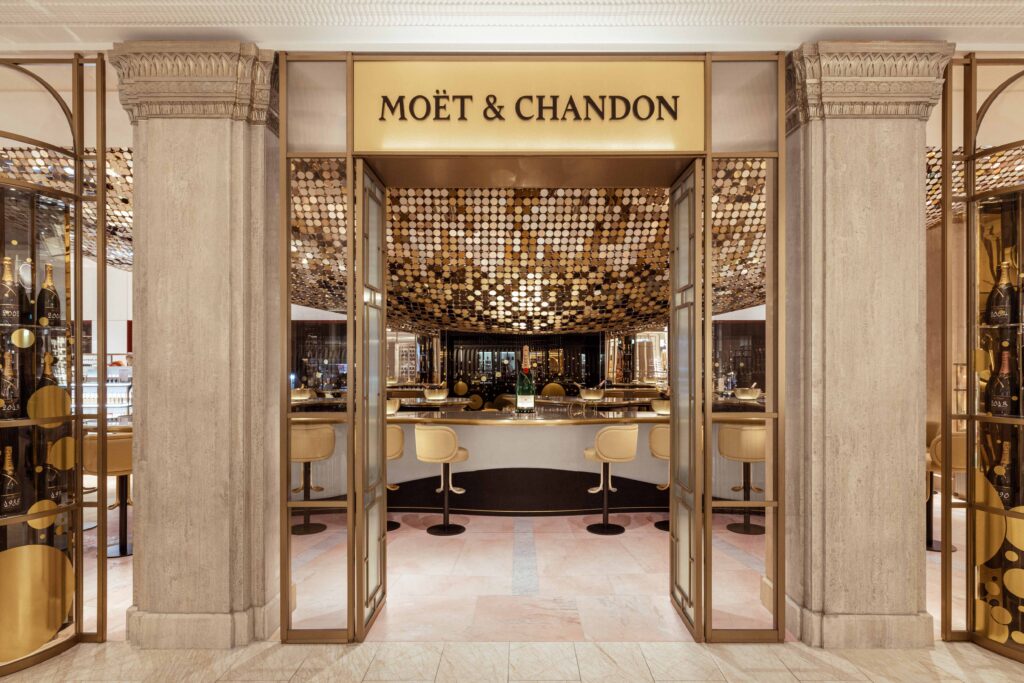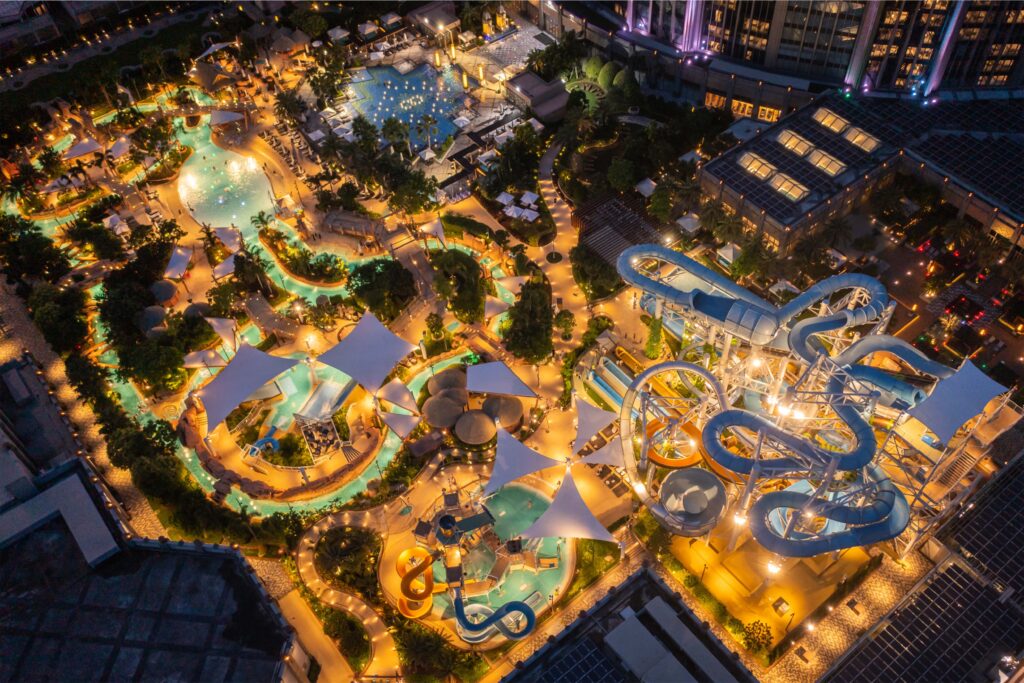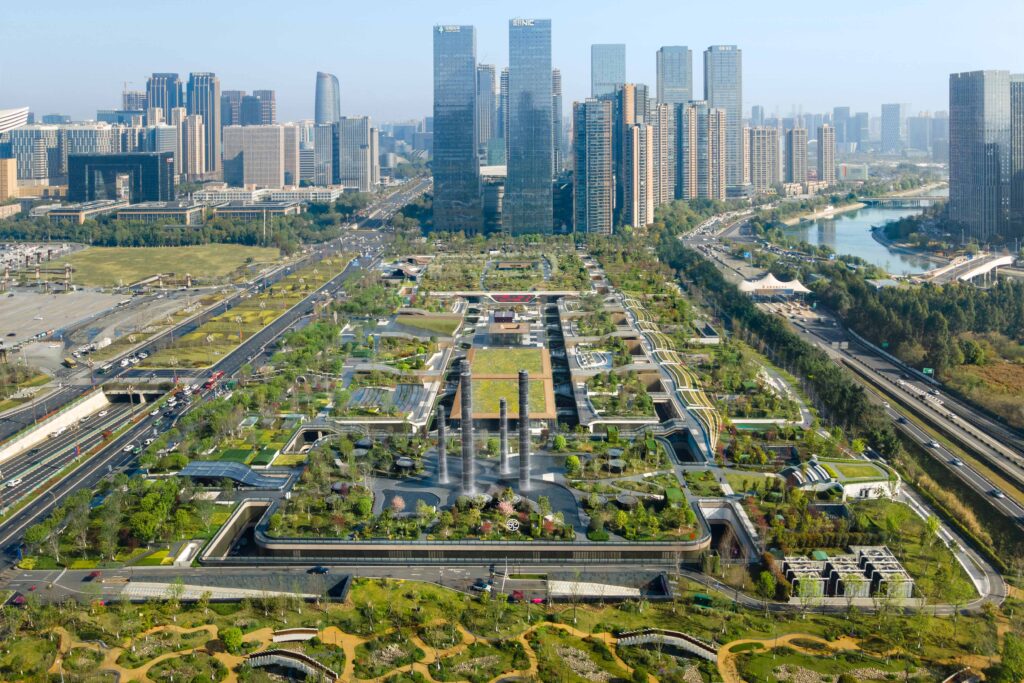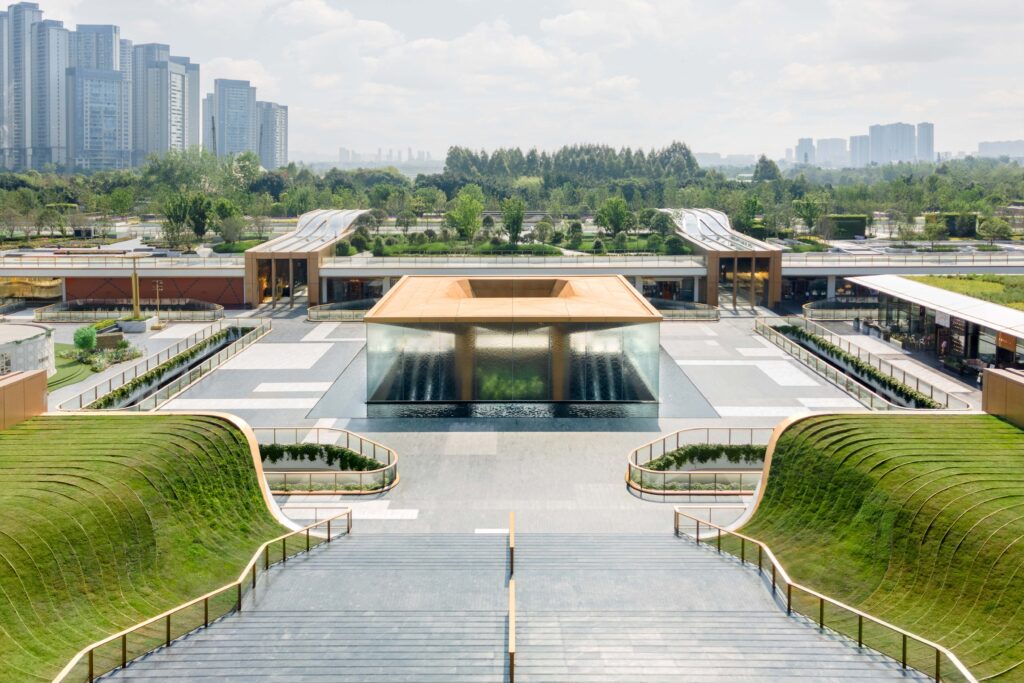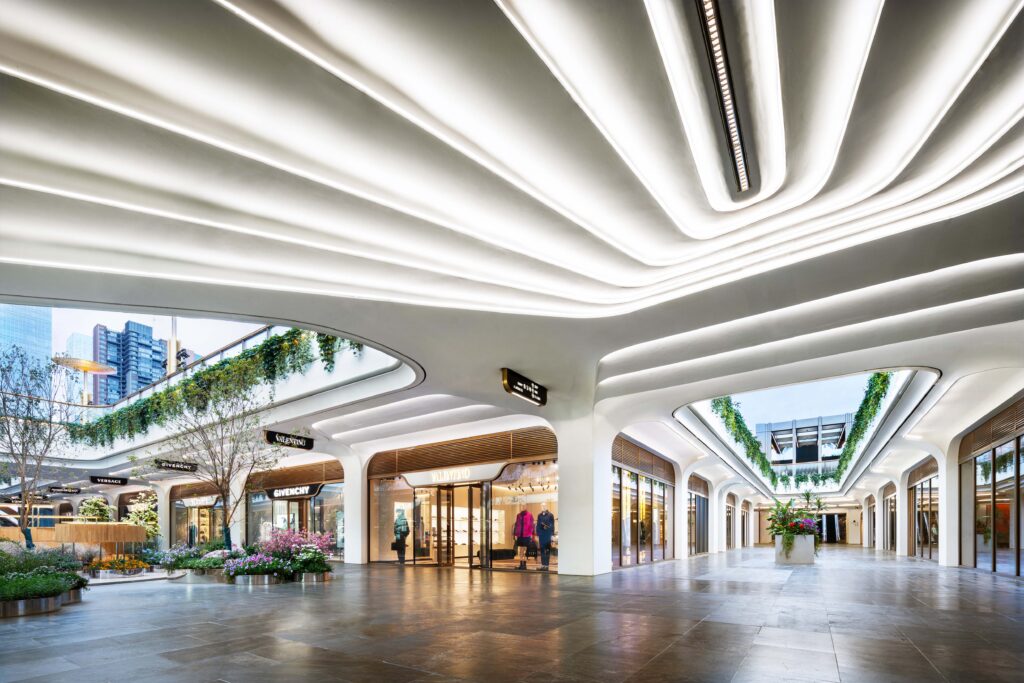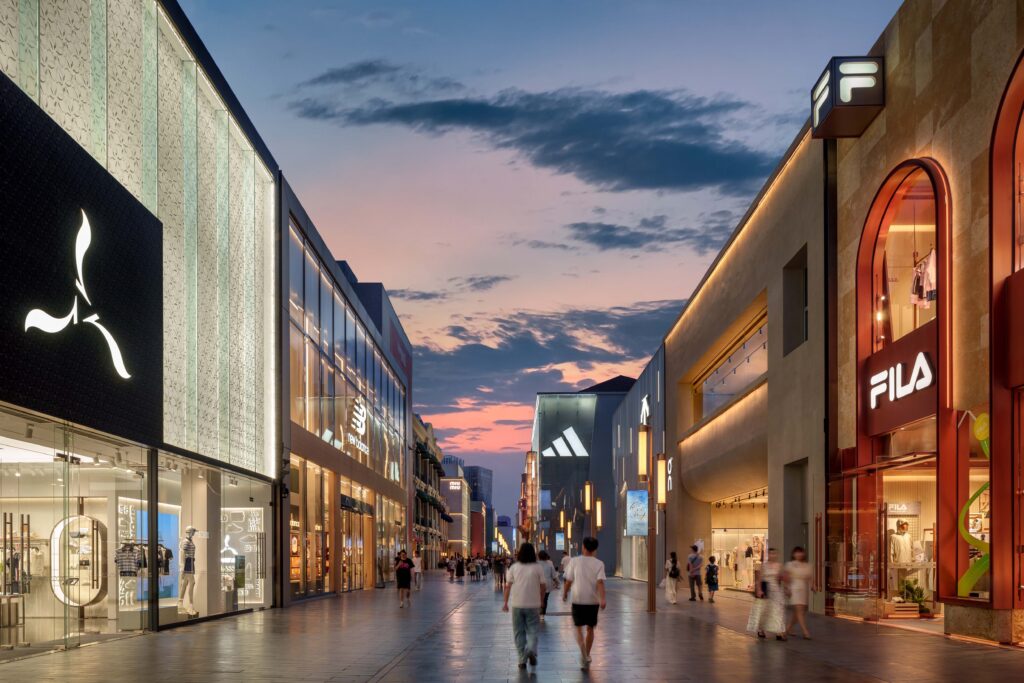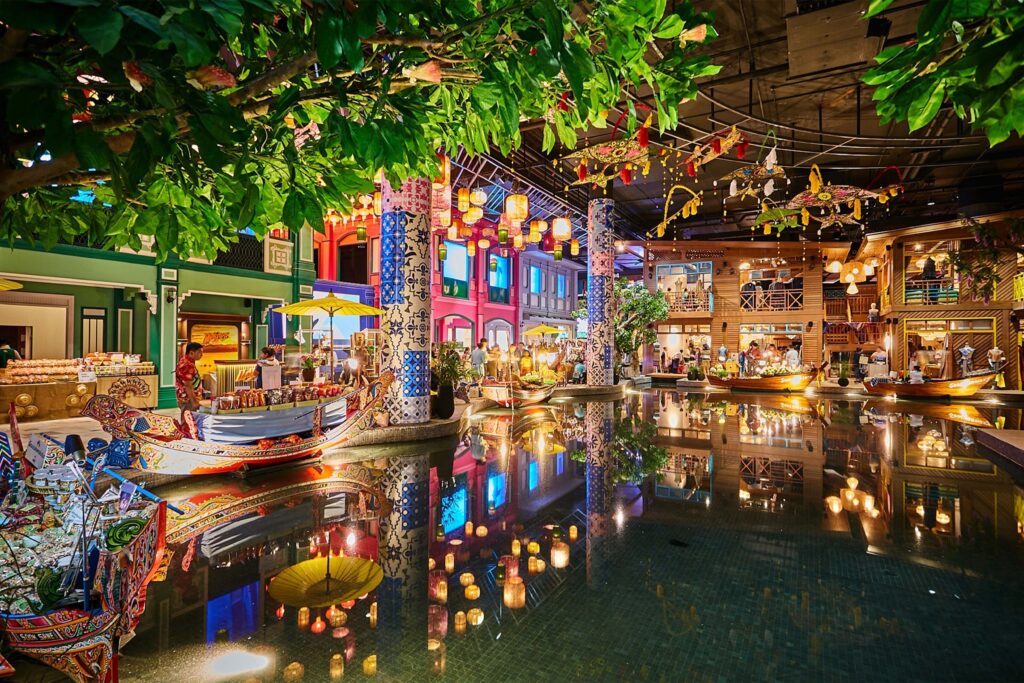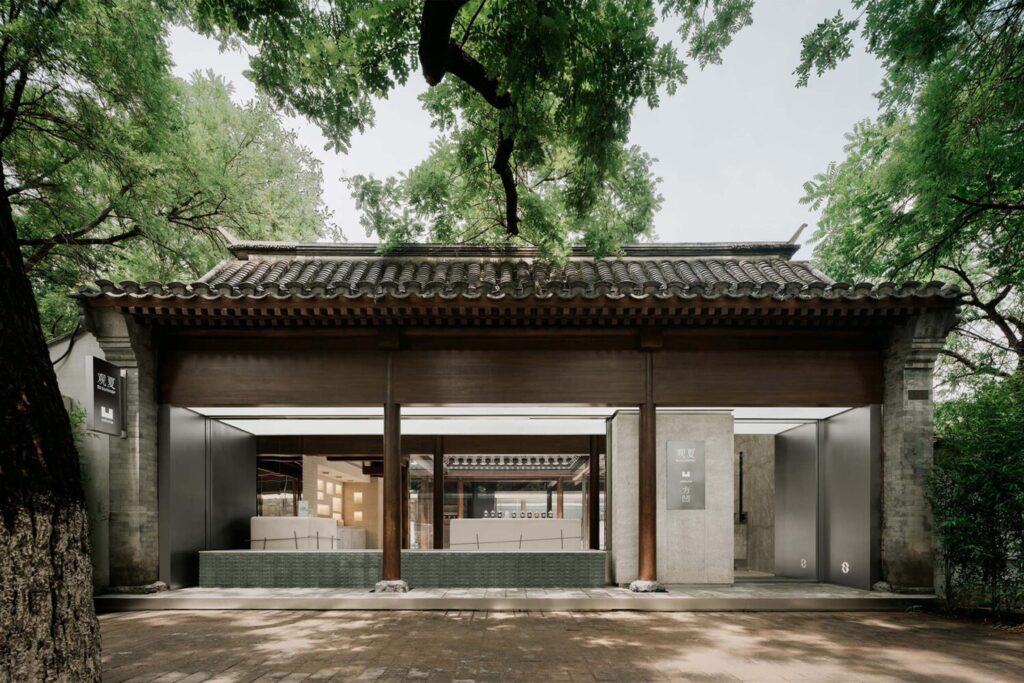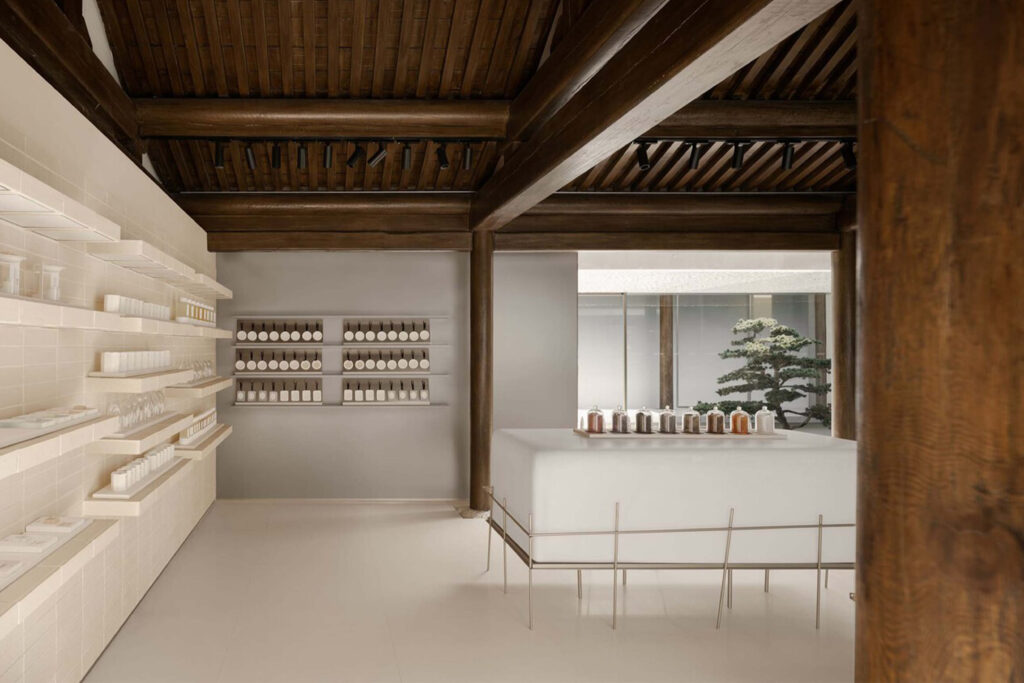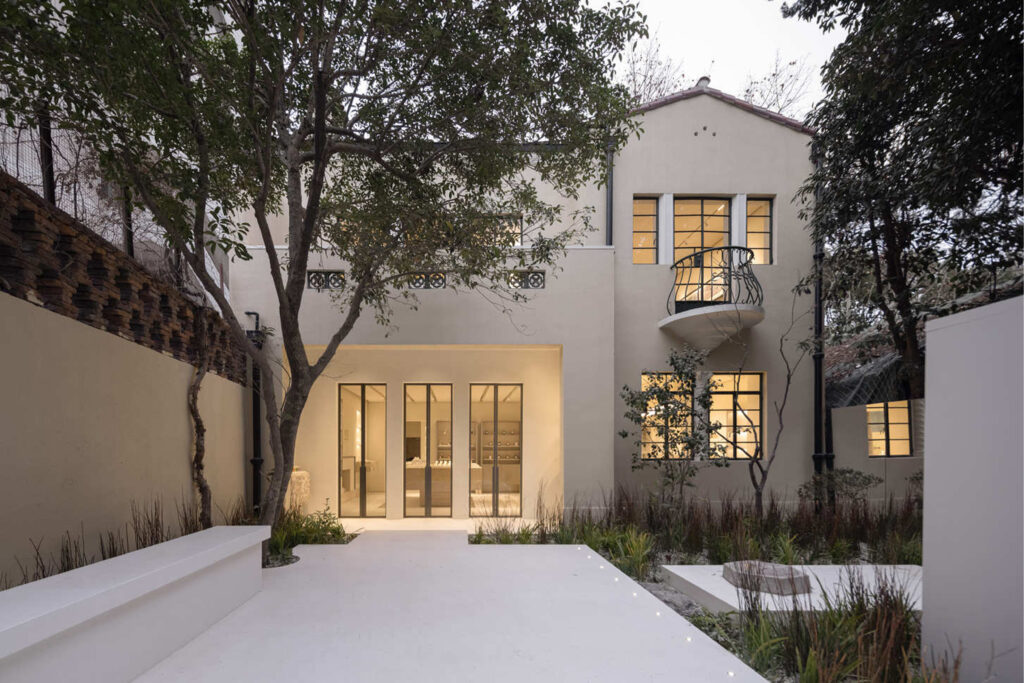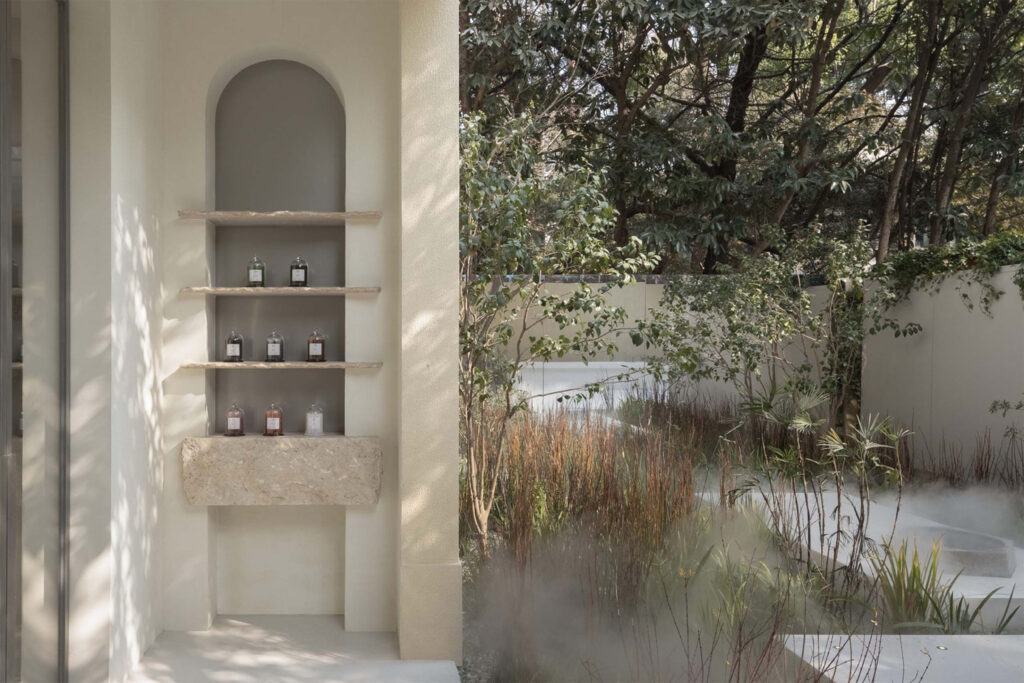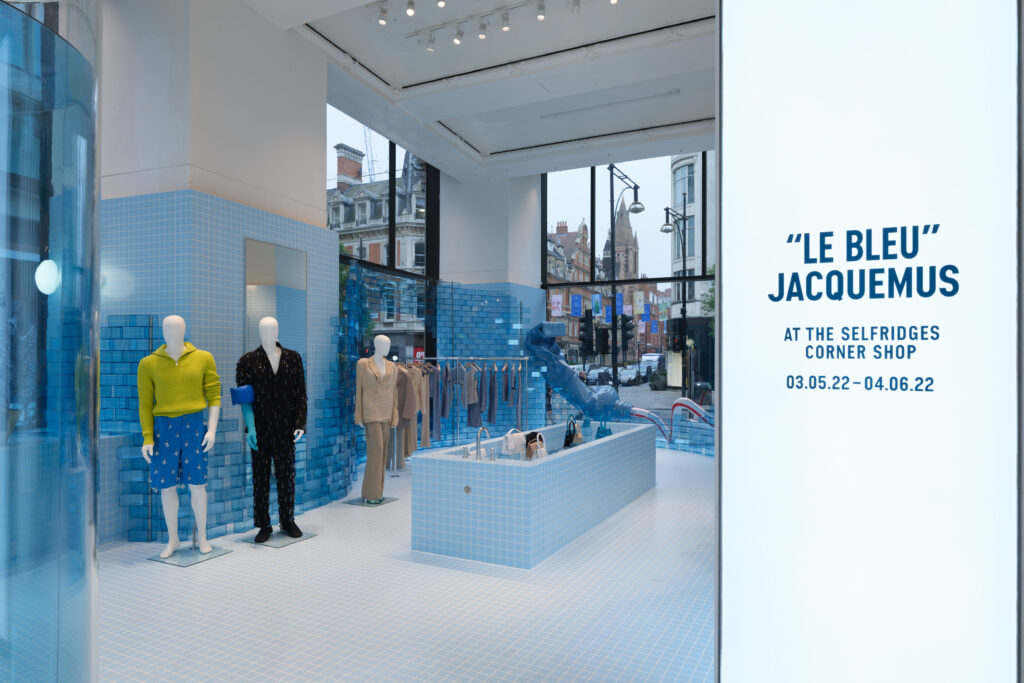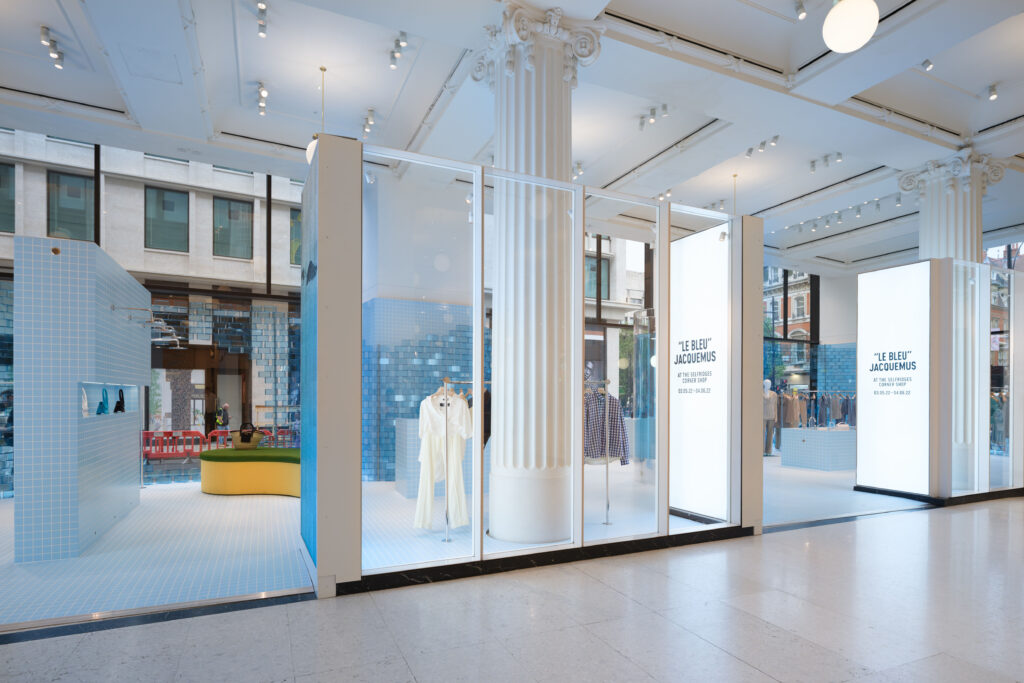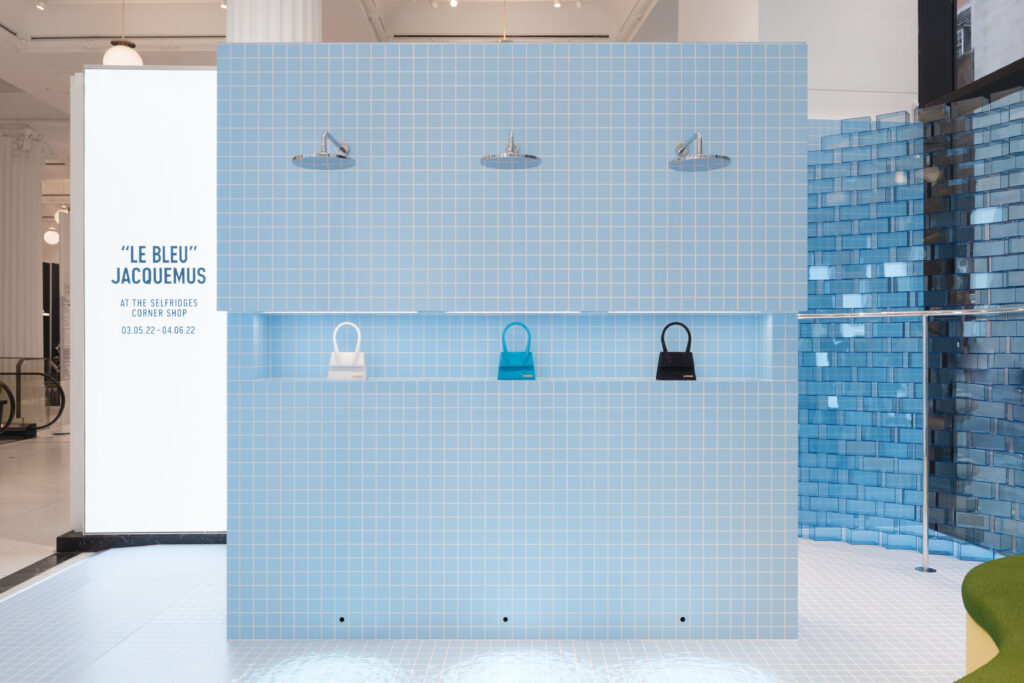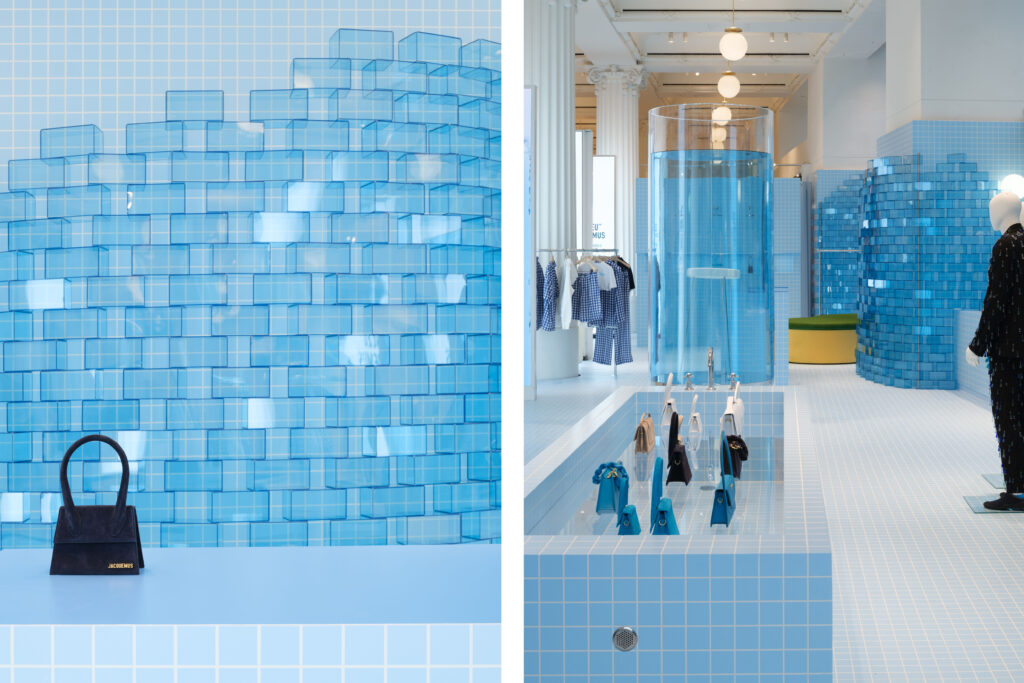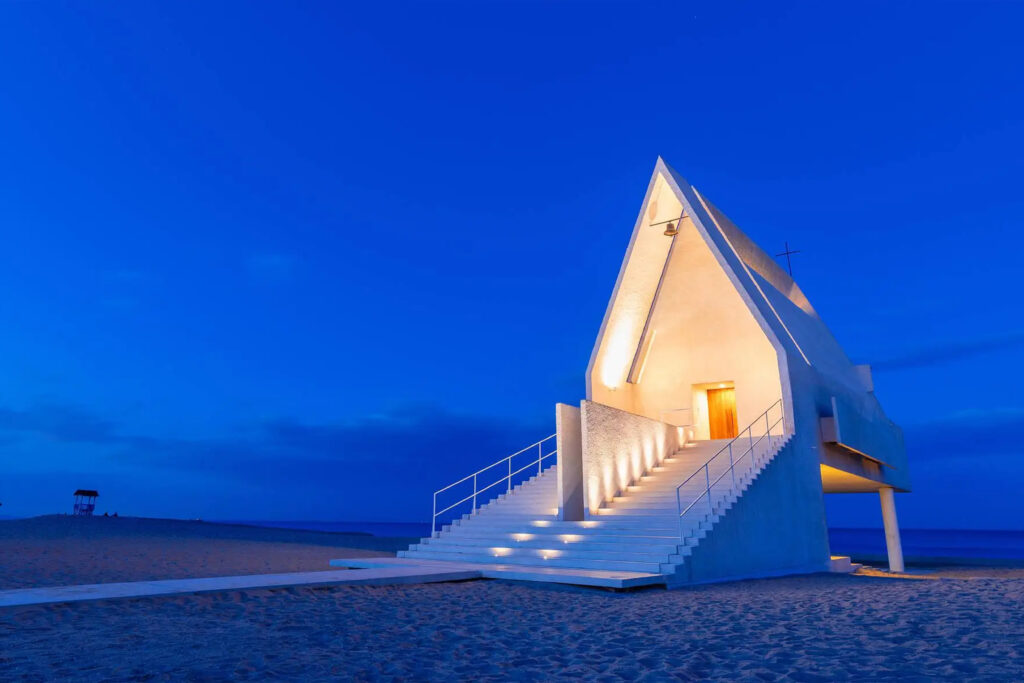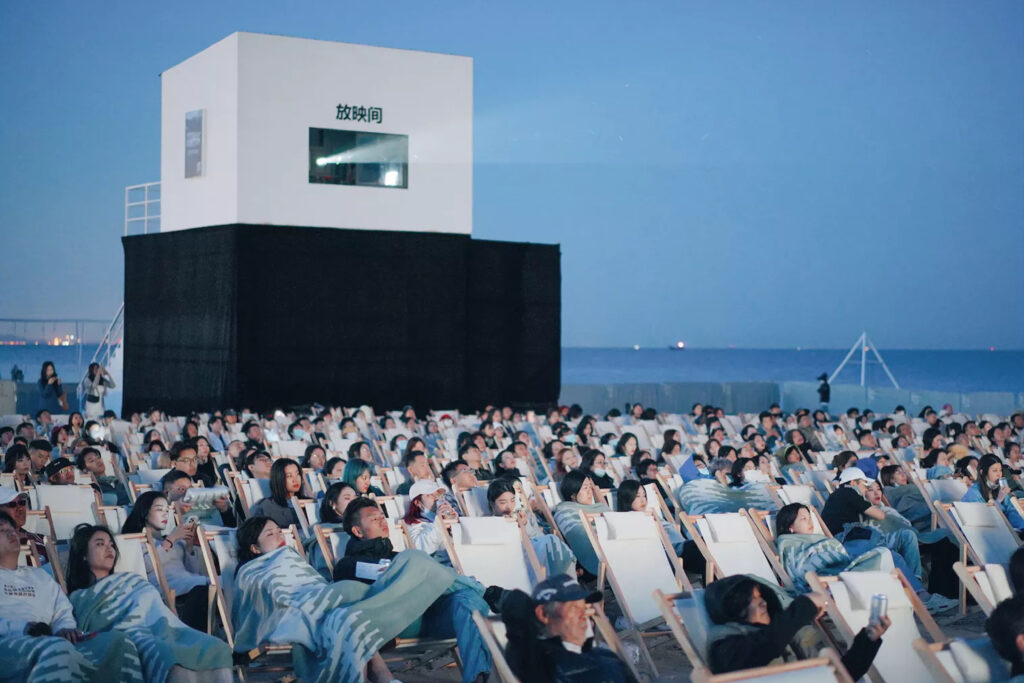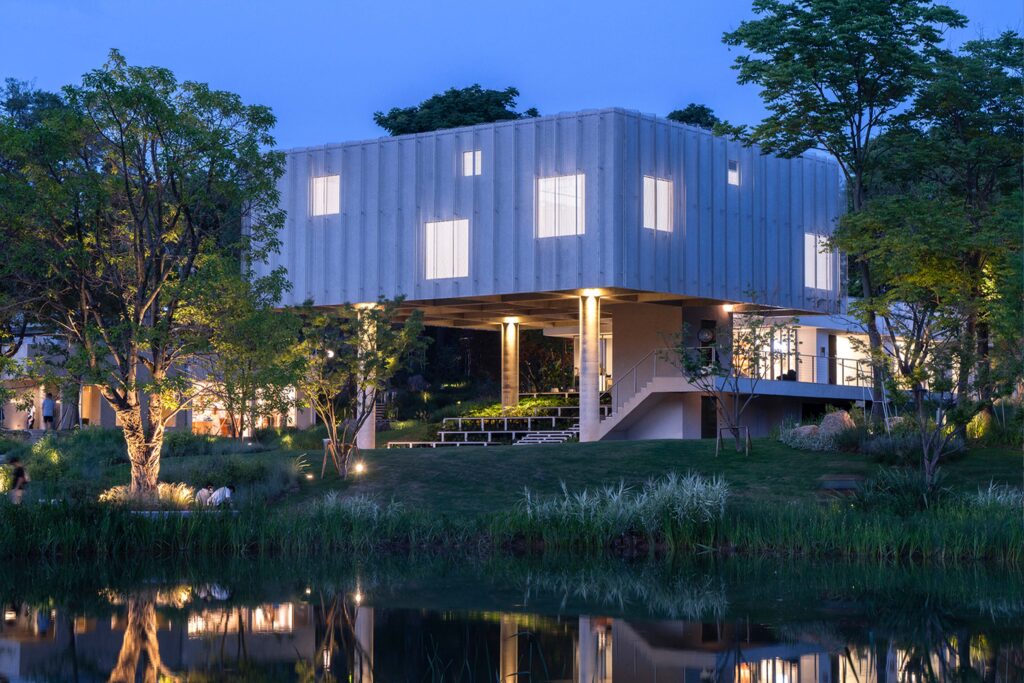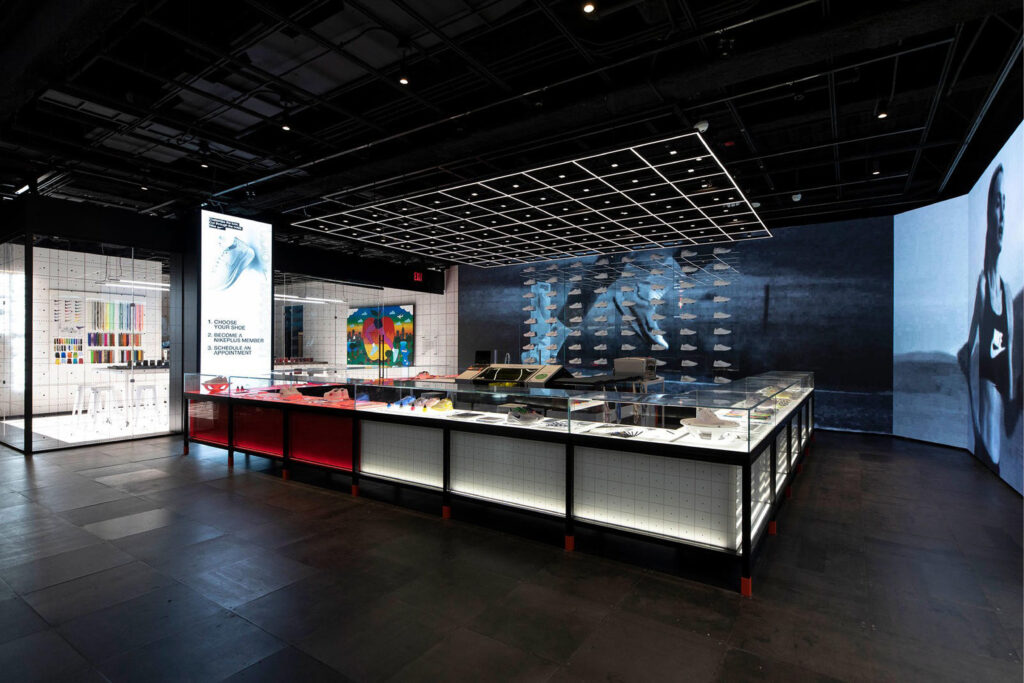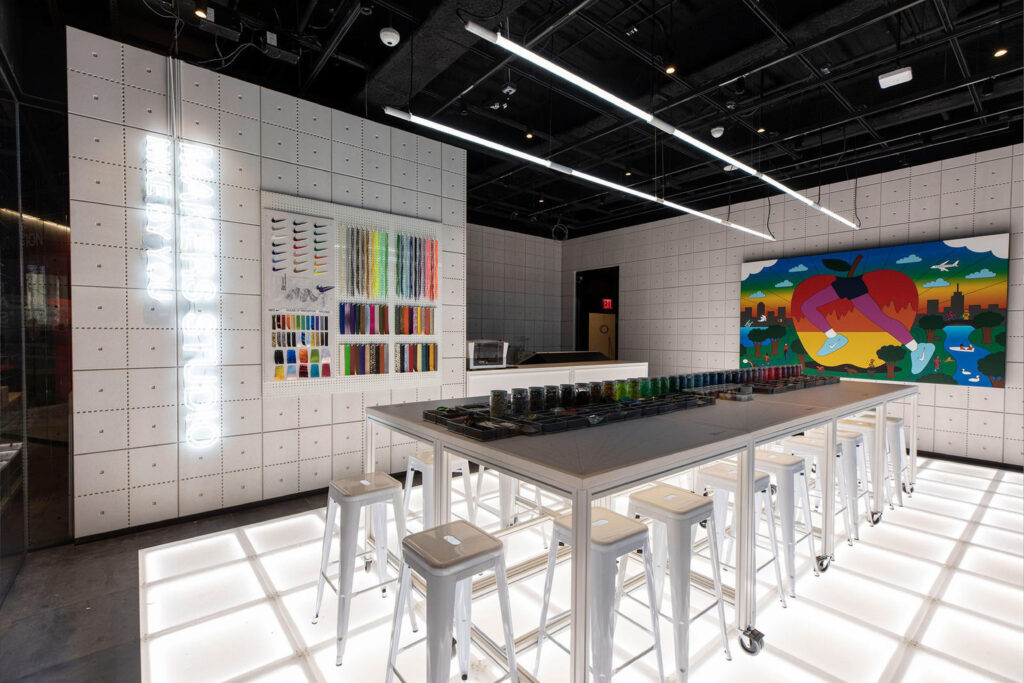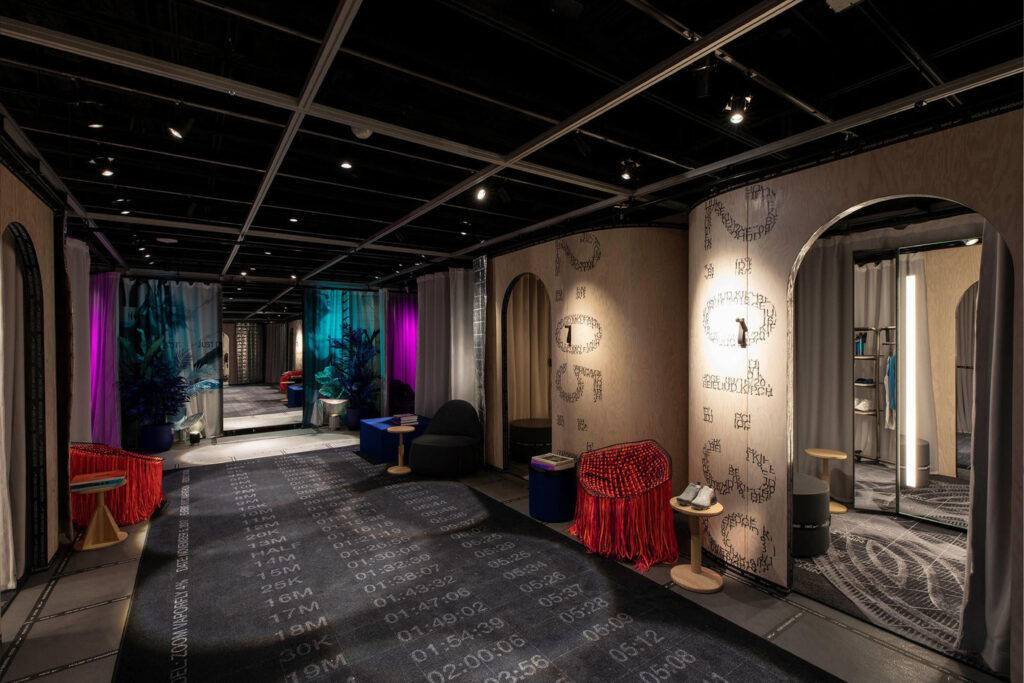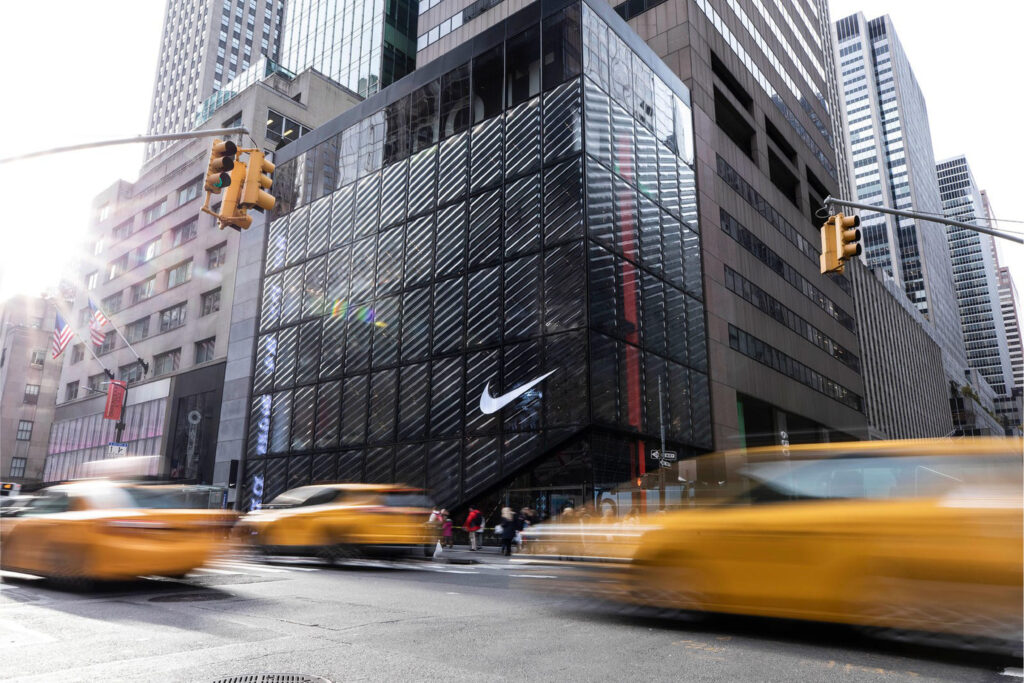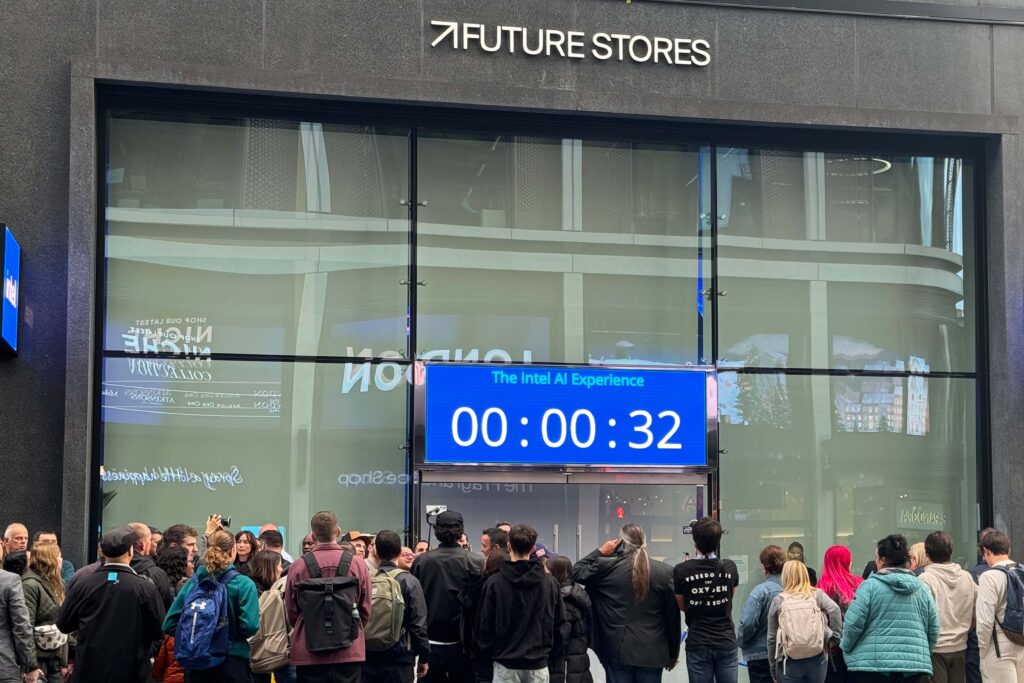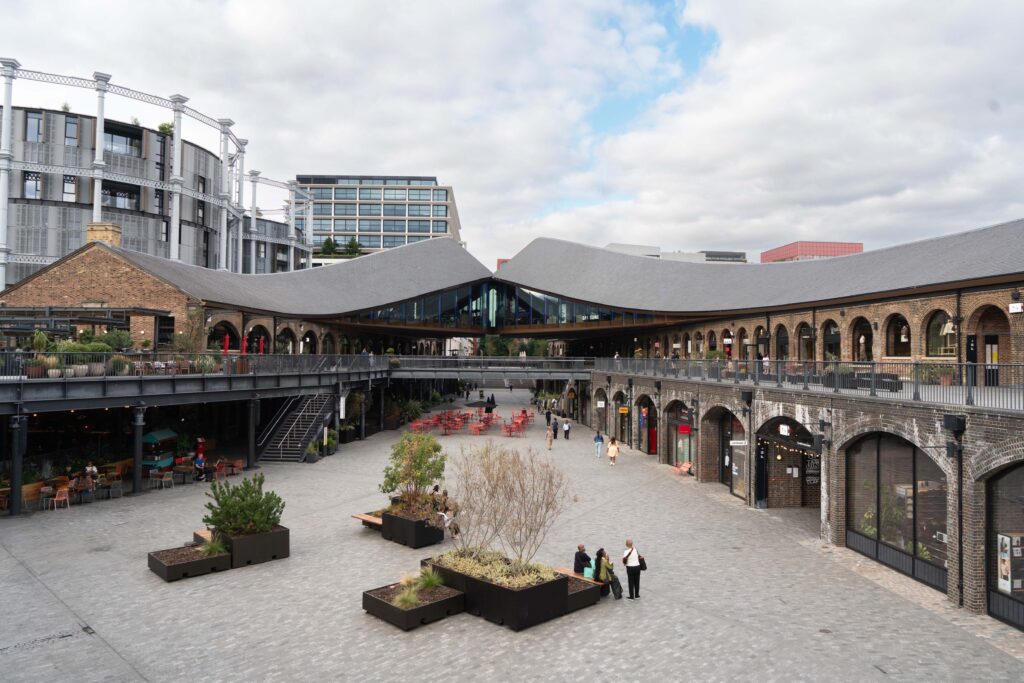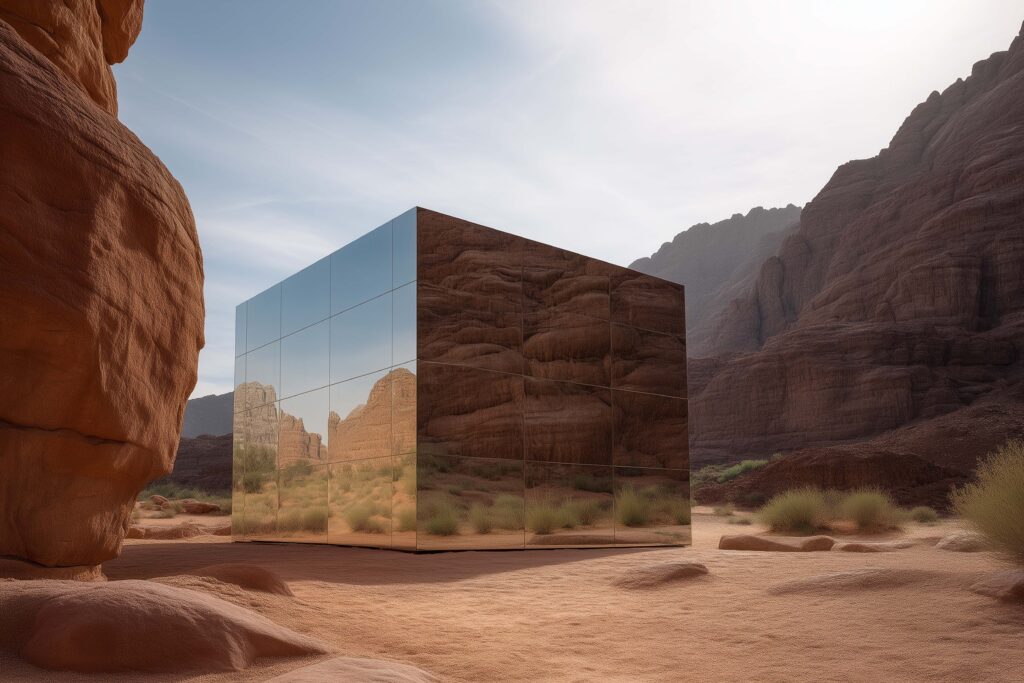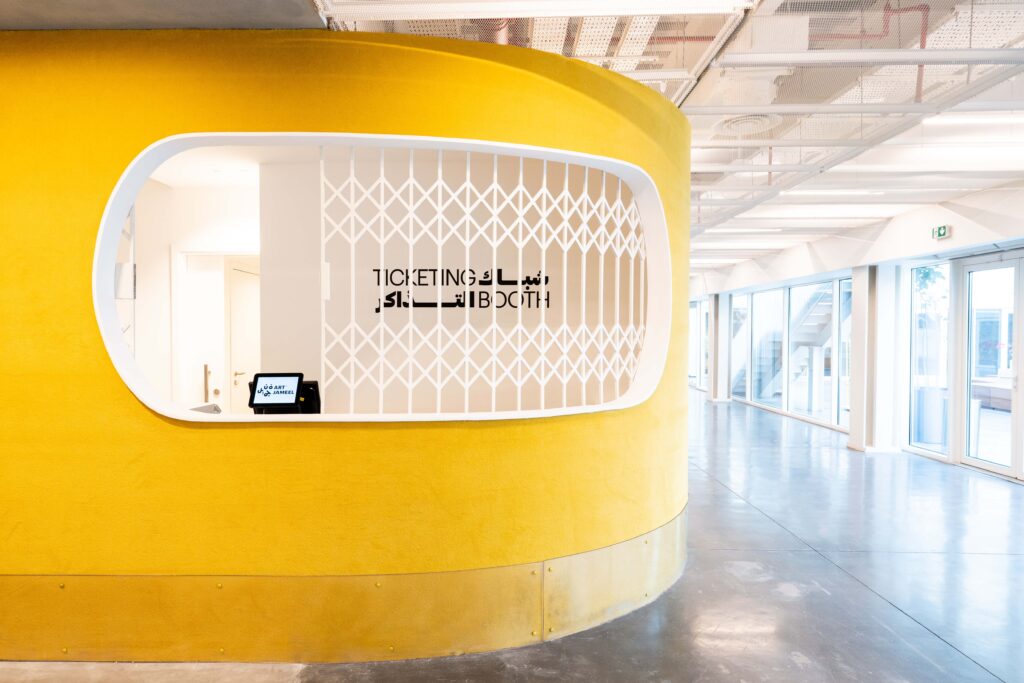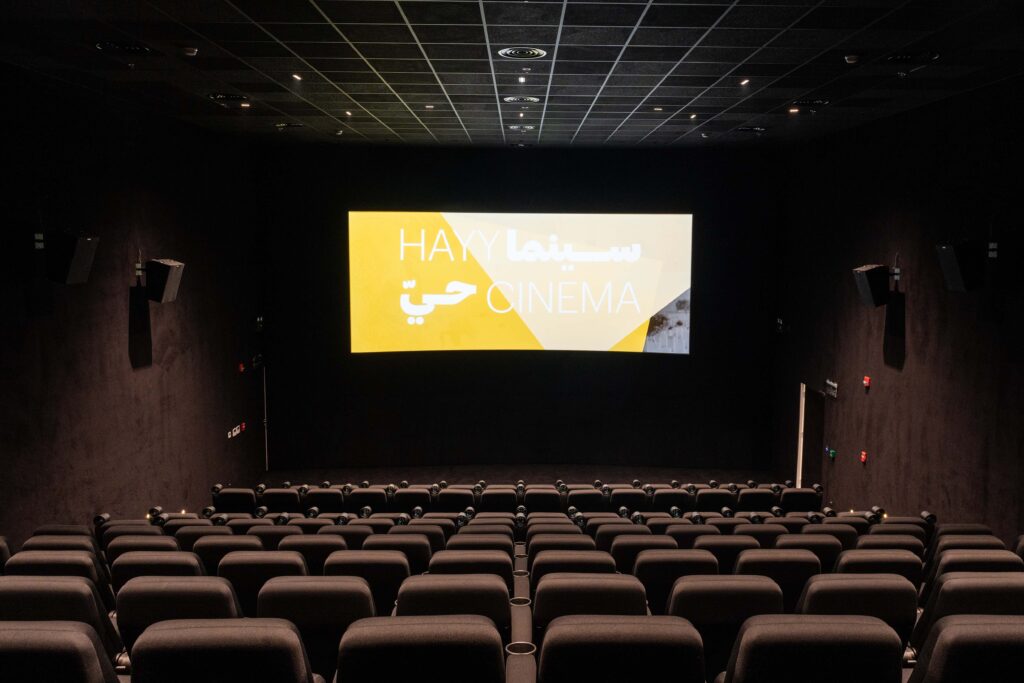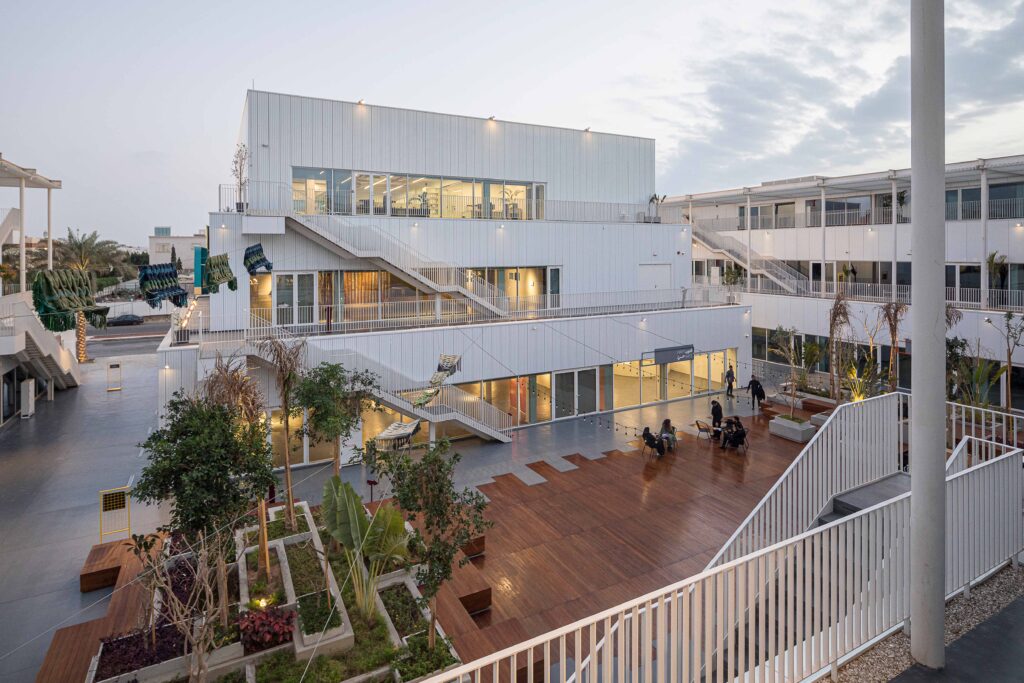Chapter 2
Decoding Tomorrow
Debunking the Myth of ‘Experiential Retail’
From indoor roller coasters to meditation rooms, and augmented reality “magic mirrors” to robot concierges, retailers in the past decade have experimented widely in the quest to redefine the shopping experience. But while some innovations – like food and beverage offerings – have become standard in store design, many others faded as quickly as they appeared. What’s emerging now is not a rejection of experience, but a more evolved, purpose — driven vision of retail.
The experiential retail wave of the 2010s, marked by pop-ups, photo ops, and Instagrammable decor, often mistook spectacle for substance. These spaces attracted foot traffic but rarely cultivated meaningful connection, loyalty, or conversion. Retailers like Glossier and Showfields created stores that resembled interactive art installations more than functional retail environments – fun to visit, but forgettable as shopping destinations. Experience was too often skin-deep.
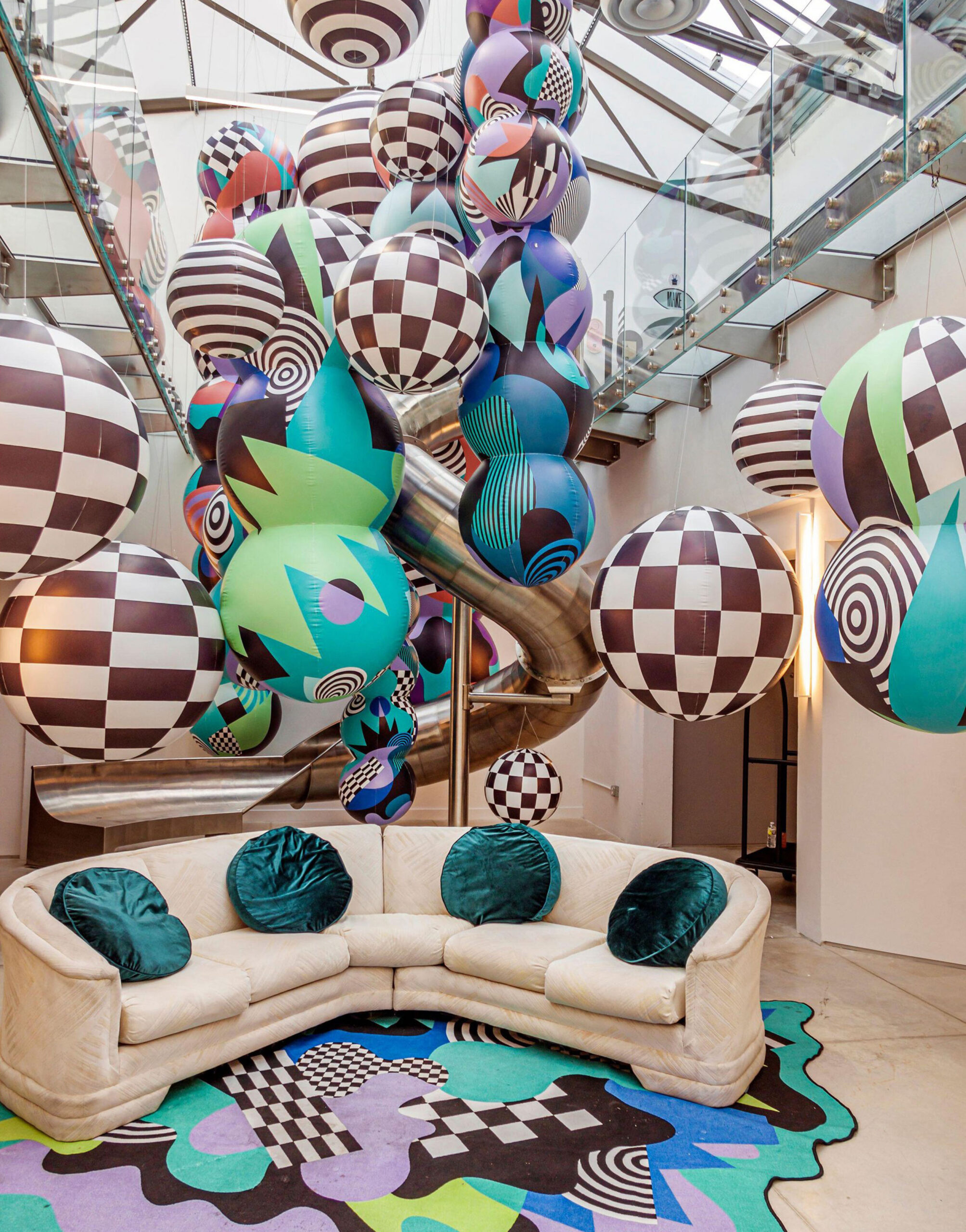

In contrast, today’s leading-edge retailers are channelling the enduring lessons of legacy icons like Le Bon Marché into a new framework, one defined by integration, innovation, and deep engagement. We are now entering the age of hyper-hybrid retail: a layered, multidimensional approach where retail is not just a transaction or a show, but an immersive journey that blends service, hospitality, architecture, entertainment, and community. Experience is no longer an add-on; it’s the operating system.
Retail is also being reimagined as a true destination, far beyond the idea of a well-designed sense of place. Stores like SKP-S in Beijing or Dover Street Market in London don’t just sell products, they draw visitors as cultural landmarks. People don’t just shop; they explore, linger, and return. These spaces function as galleries, studios, and social hubs, reflecting a world where retail competes not just with other stores, but with restaurants, museums, and even travel.
Supporting this shift is a new era of retail architecture: spectacular, otherworldly environments that elevate the act of shopping to a form of pilgrimage. Think of Heatherwick Studio’s Coal Drops Yard in London — this structure signals ambition and permanence, positioning retail as a form of urban theatre where design doesn’t just house commerce – it defines it.
At the same time, technology is transforming retail into what’s known as a phygital frontier. The best retailers now weave digital seamlessly into the physical world – not as a gimmick, but as an invisible layer of utility and personalisation. Whether it’s AI-driven product recommendations or app-enabled loyalty programs, digital tools now enhance, rather than distract from, the core shopping experience.
Most profoundly, we’re seeing retail as a catalyst: a force that can actively shape the cities of tomorrow. From mixed-use developments to mobility hubs and community programming, retail spaces are increasingly being designed as civic infrastructure. The store is no longer just a place to buy; it’s a place to gather, recharge, and reconnect. As urban life becomes more fragmented and digitised, physical retail offers something uniquely valuable: the ability to anchor neighbourhoods, inspire creativity, and bring people together.
In the end, the lesson from Le Bon Marché wasn’t about spectacle; it was about evolution. Boucicaut created more than a store; he created a new way of living, shopping, and socialising. Today’s pioneers are doing the same, not by chasing trends, but by embracing experience as a fully integrated, multidimensional strategy. This isn’t the end of experiential retail – it’s its reinvention.
Welcome to Conformity
By Rob Campbell, Partner & CSO, Uncorporated
The truth be told, the words ‘brand experience’ have been long misunderstood, often interpreted as needing to provide ‘lowest common denominator consistency’ rather than creating seminal brand experiences for customers’ possibilities.
The result of this attitude has been a seemingly endless production line of category complicity.
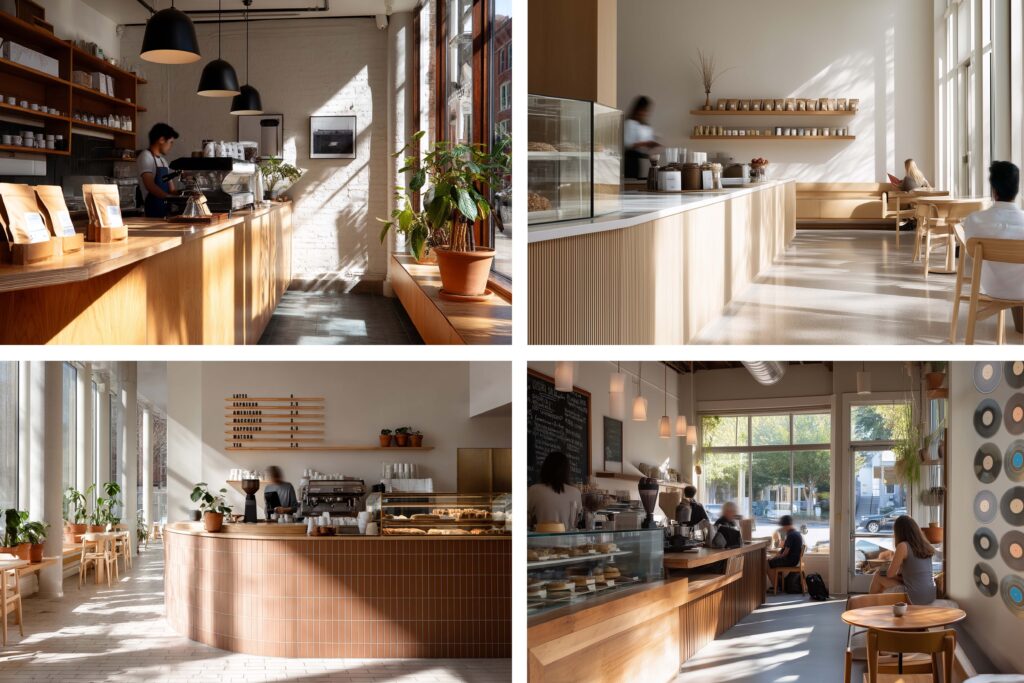
The need to invest in a differentiated, distinctive and desirable brand experience is not, as many would like to suggest, an act of creative vanity, but actually one of commercial sanity. With globalisation and technological advancements, any innovation can be replicated and distributed by competitors in increasingly shorter timeframes. The impact of this on driving brand value and customer loyalty is significant because it removes tangible reasons why a customer would choose one brand over another. It is for this reason we are witnessing an increasing number of companies see brand experience as a way to build meaningful customer engagement and loyalty rather than rely on traditional brand approaches. Put simply, design is driving the future.
Of course, this is not really a new phenomenon. Back in the early 2000’s, Virgin Atlantic used their lounge experience to drive a competitive edge over their peers. Rather than create an environment that was similar to their competitors’ offering – albeit in their corporate colours – their starting point was to ‘create a lounge that passengers would want to miss their plane to stay in.’ This approach not only allowed them to create an experience that redefined the category, it created an invigorating and infectious relationship with the Virgin Atlantic brand – helping catapult them into the consideration set of business customers that were previously unavailable to them.

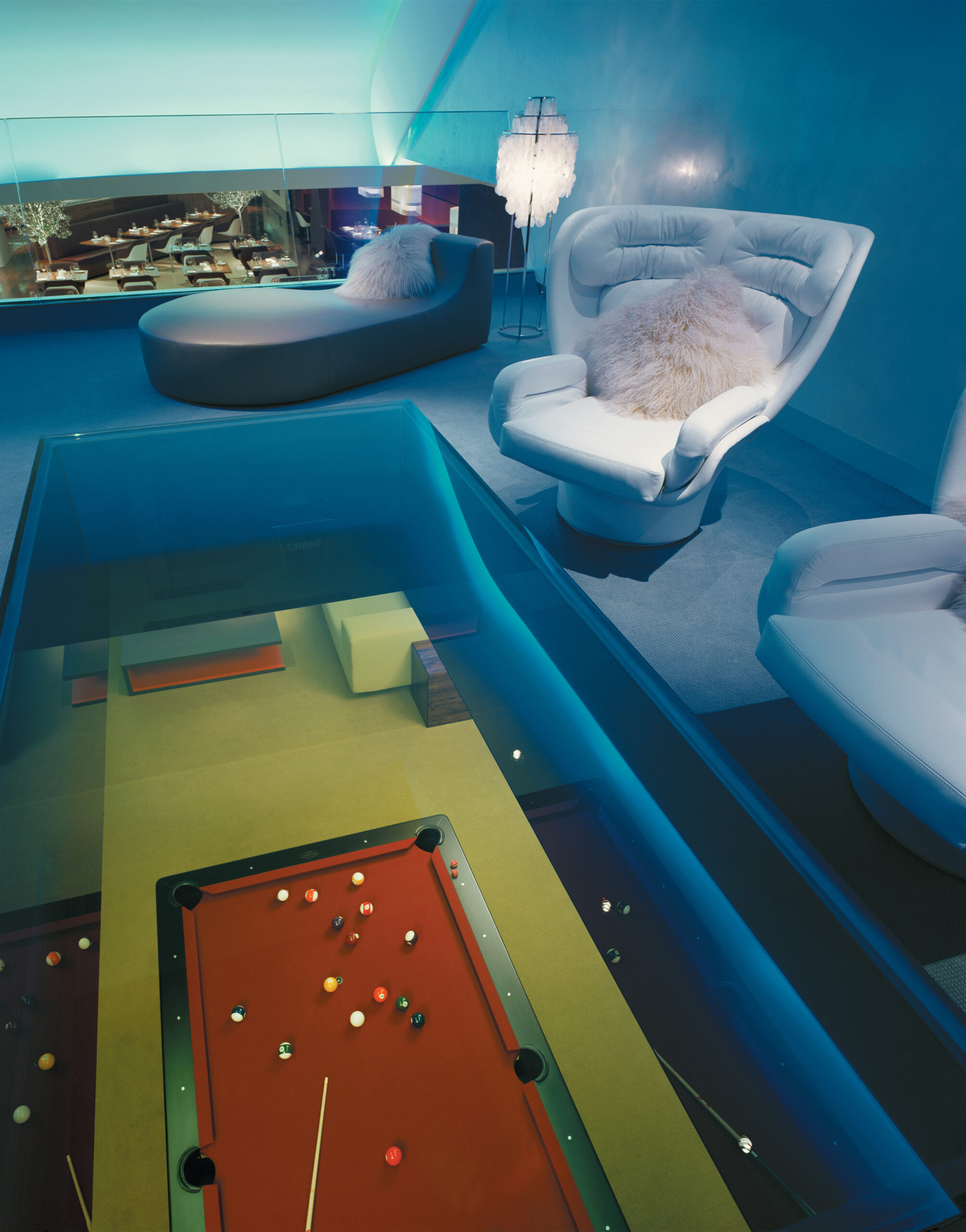
And while times have changed significantly since the launch of the Virgin Atlantic lounge, we are seeing more and more progressive brands recognise the commercial impact and value of investing in a seminal brand experience for their customers. Not just in terms of driving engagement, but also in terms of building differentiated and sustainable brand value. Given it will only get increasingly more difficult and expensive for brands to stand out, investing in a truly innovative retail experience may soon be seen as one of the most commercially responsible ways to turn your brand into a commercial beacon rather than be another offering in the long line of parity attractions.
Hyper-Hybrid Retail
In the age of digital saturation and fragmented attention, the most forward-thinking retailers are no longer just offering products or even “experiences” in the traditional sense. They are creating multidimensional ecosystems: living, breathing environments where retail blends seamlessly with hospitality, entertainment, culture, and service. This is what we’d like to call Hyper-Hybrid Retail, a paradigm that builds on the foundational lessons of institutions like Le Bon Marché, but amplifies them into something more dynamic, integrated, and immersive.
Nowhere is this more vividly realised than at Emsphere in Bangkok. Designed not as a conventional mall but as a vertical village of interconnected experiences, Emsphere challenges the very architecture of retail. Each floor is deliberately unique, with thematic zoning that provides visual and experiential distinction while maintaining overall cohesion through a raw, industrial design language. Rather than a homogenous flow of stores, the journey through Emsphere is one of constant discovery. Even the functional elements of the building, including escalators, skybridges, atriums, have been transformed into expressive platforms. These are no longer mere passageways; they become sites of artistic activation.
What truly sets Emsphere apart is its ability to evolve over time and throughout the day. In the morning and afternoon, it hums with the energy of retail, gourmet markets, and artisanal cafes. By evening, the space transforms into a vibrant social hub, animated by rooftop bars, live music, and illuminated courtyards. The building shifts its mood like a city in miniature, where retail becomes a time-responsive, emotionally attuned environment. Strategically, Emsphere also reconfigures conventional mall logic by placing an IKEA on the fourth floor. This unexpected move recalibrates visitor flow, drawing traffic upward and distributing energy throughout the entire vertical footprint.
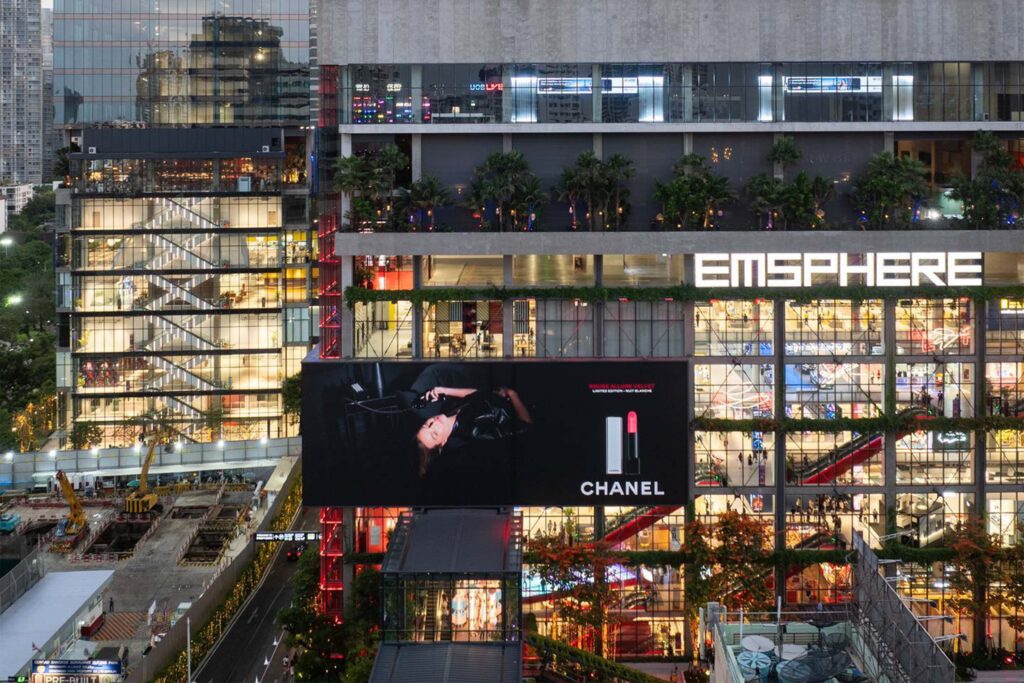
Emsphere, Bangkok, Exterior – Source: Design 103.
The same ethos is evident in Anya Hindmarch’s Village in London, a whimsical reimagining of the flagship store that has become a branded neighbourhood unto itself. It’s a fully immersive brand world that includes a café, ice cream shop, salon, and a revolving series of cultural and sustainability-focused activities. Instead of organising around categories of product, the Village is designed around rhythms of life: moments of play, self-care, socialising, and creativity, all delivered with Anya’s signature wit and craftsmanship.

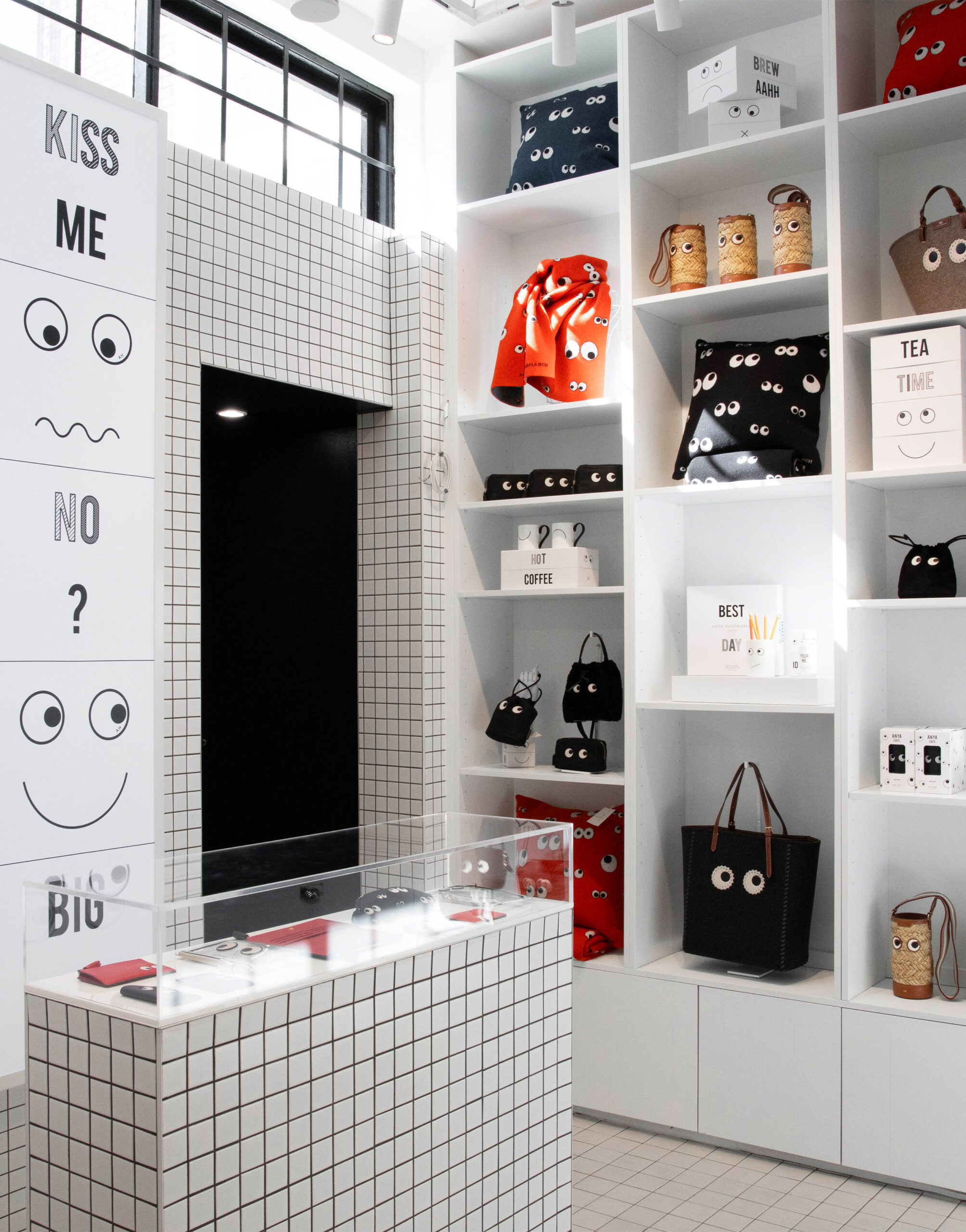
This hybridisation is not limited to traditional fashion or luxury players. Increasingly, we’re seeing cross-sector collaborations where the lines between commerce, culture, and service are intentionally blurred. Brands launch their drops inside fitness clubs and even grocery stores, such as Alo Yoga’s collaboration with LA grocery chain Erewhon. Boutique hotels are hosting rotating retail capsules in their lobbies, and even furniture brands have become fashion collaborators: Think Fendi Casa or tie-ups like Off-White x IKEA. These new hybrids are not random pairings. They are curated ecosystems designed around shared values, audience overlap, and lifestyle alignment. They acknowledge a profound truth: that today’s consumers don’t segment their lives into neat categories, so retailers shouldn’t either.
Hyper-Hybrid Retail represents a decisive evolution from spectacle-based experiential design toward something more sophisticated and sustainable. It integrates food and beverage not as filler, but as fuel for deeper engagement. It prioritises architectural storytelling over surface — level decoration. And it treats retail not as an isolated commercial act but as a platform for participation, co-creation, and emotional connection.
What began with Boucicaut’s vision of turning shopping into a pleasure has now matured into something far more ambitious: retail as an orchestrated ecosystem, where every space, product, and interaction is part of a unified, immersive whole.
The Age of HyperHybridity
By Simon Mitchell, Co-Founder, Sybarite
If Hyper-Hybrid Retail represents a conceptual evolution in retail philosophy, then Hyper-Hybridity is its actionable framework – a design-led, operational shift from static environments to curated, dynamic ecosystems. This is not a departure from traditional retail models, but rather a transcendence of them.
The pre-Hybrid traditional leasing model still underpins the vast majority of global retail environments, and yet, it fails to reflect how people engage with brands today. The pre-Hybrid formats – often monolithic, monotone, and purely transactional – fail to foster the emotional and cultural engagement contemporary audiences demand. They permit brand occupancy but not brand flourishing.
Retail pioneers such as Harrods, Selfridges, and SKP have shifted towards a more editorial Hybrid approach – merging direct operations with curated narratives. SKP-S, the subversive sister of SKP, exemplifies this progression. Composed of over 60 percent experiential and cultural programming, SKP-S offers a new paradigm in which retail is reimagined as a multidimensional journey – immersive, emotionally charged, and future-proof.
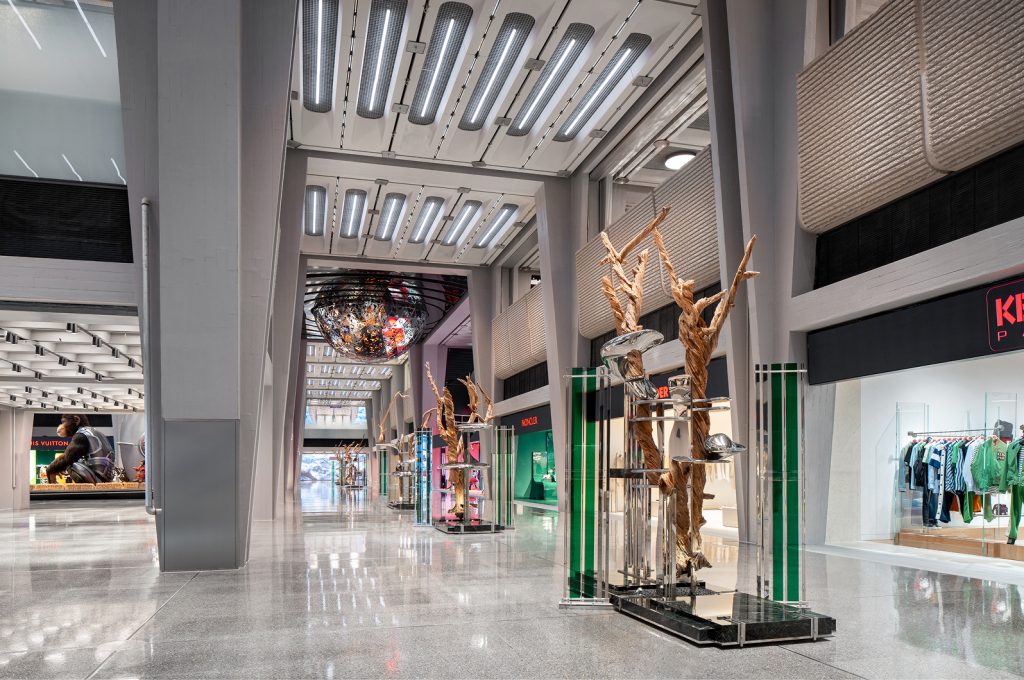
SKP-S, Chengdu, 1F Fashion – Photography: Nick Kuratnik; Source: Sybarite.
The Hyper-Hybrid model demands 100 percent curation across every aspect of the retail environment. This is not a utopian ideal, rather an operational mindset that reshapes how retail is conceived and experienced. The grand department stores of the past – Harrods, Le Bon Marché, Steen & Strøm – once offered fully curated collections; although full curation may no longer be financially viable in the traditional sense, the intent behind it has never been more critical.
Harvey Nichols is currently embarking on a brand refresh and repositioning that involves the redesign of the ground floor of its iconic Knightsbridge flagship. Envisioned as a ‘Living Magazine,’ our team at Sybarite took inspiration from the editorial heights of 90s London, imbuing the space with a curated and eclectic energy, which will bring together fine jewellery, sunglasses, homewares, design objects, accessories, fragrance, and beauty in an ever-evolving composition. The intention is not only to curate but to create a setting that remains agile — responsive to cultural moments, open to surprise, and attuned to how customers wish to explore and connect.
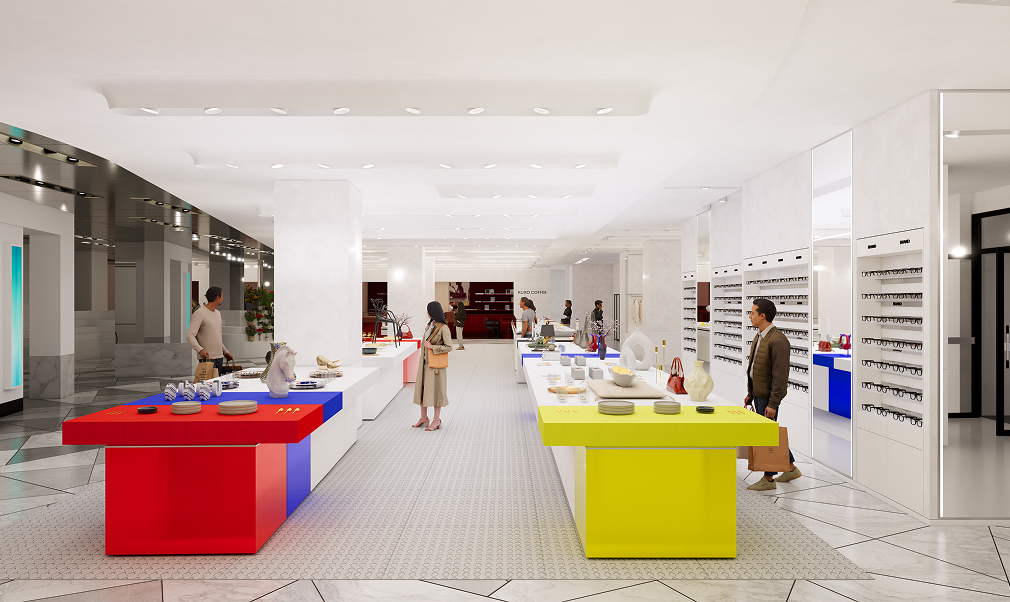
Successful retail destinations today do not merely serve categories – they respond to behavioural cadence. They are attuned to cultural shifts, delivering continuous activation and renewed relevance. In this context, design is no longer reactive, it must anticipate and articulate what comes next.
One of the most compelling aspects of Hyper-Hybridity is the unexpected pairing: camping gear beside couture, a champagne bar in the heart of a beauty hall. These are not design quirks – they are deliberate juxtapositions that mirror the eclectic lives of modern consumers.
In our recent explorations into the future of retail, we have uncovered compelling opportunities to integrate unexpected categories into future department stores or shopping malls. From premium children’s education programmes and bespoke birthday party packages to live-streamed e-sports tournaments and virtual reality laser battles – these seemingly unconventional offerings respond to the emerging needs of today’s consumers. More importantly, they allow brands to cultivate connections with their audiences that transcend the transactional.
Luxury brands, in particular, have an unprecedented opportunity to extend their narratives beyond product. Through cross-sector collaborations – with fitness, wellness, education, entertainment – they can create immersive, emotionally resonant ecosystems.
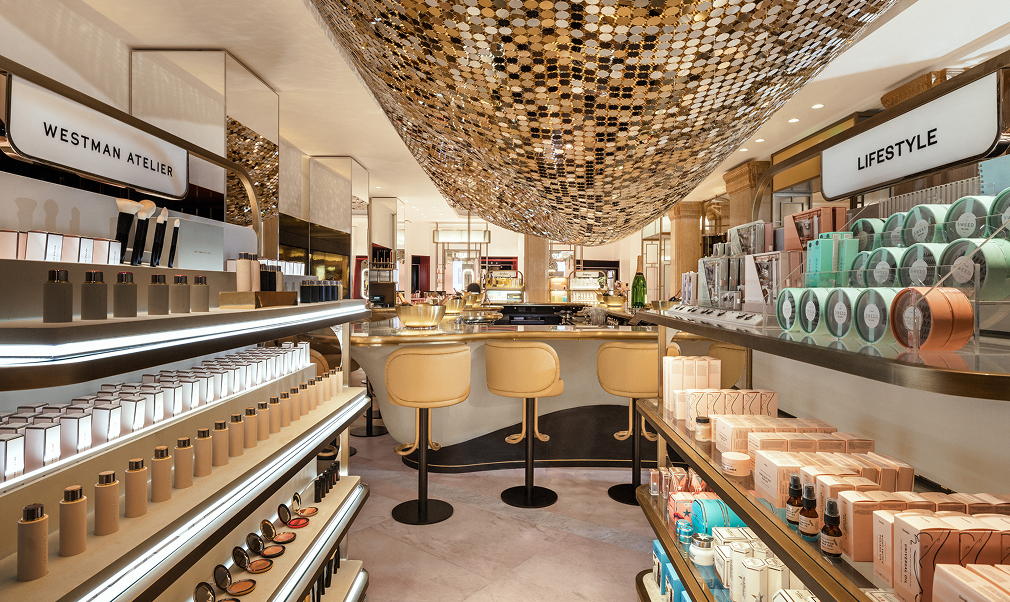
Emsphere in Bangkok embodies this disruptive spirit. A radical reimagining of retail architecture, it places food curation at lower levels and car showrooms, carparks, and nightclubs above – in-turn subverting spatial expectations and freeing the retail canvas. Its raw architectural skeleton allows brands to pivot fast, leaving room for spontaneity and local energy.
What emerges is not just spatial disruption but spatial liberation: a framework where flexibility is built in, and the unexpected becomes the norm.

This thinking similarly informed our work with Harrods on the Moët & Chandon Champagne Bar. Located at the heart of the Beauty Hall, it interrupts the expected with a luxurious moment of pause and celebration – a place where commerce meets culture, and surprise drives memory.
These are just two examples among countless possibilities, whether through a complete architectural overhaul or an innovative plug-in, the key is to view retail design with fresh and critical eyes. Disruption does not always mean scale.
Where Europe and the US are often hindered by structural regulation and planning inertia, in contrast, Asia and the Middle East embrace velocity. They have become the incubators of innovation, where retail formats evolve quickly, supported by technology and empowered consumers. China’s digital infrastructure – from WeChat-enabled payments to live streamed commerce – has redefined retail rhythms. In conjunction, the Middle East is constantly cultivating a new generation of culturally embedded, globally minded consumers.
Retailers in these regions are not afraid to merge fashion with e-sports, fitness with education, or hospitality with retail. Their ambition – and the governance frameworks that support it – offers a blueprint for the global market. The Box in Beijing, with its 95 percent curated offer, and Macau’s multi-use entertainment centres signal a shift toward Hyper-Hybridisation that is faster, braver, and more experimental.
As retail becomes more saturated, the need for differentiation intensifies. The Hyper-Hybrid model enables brands to carve out distinctive identities through spatial fluidity, storytelling, and immersion. This is not about fixed categories or rigid formats – it is about building dynamic ecosystems responsive to cultural, emotional, and social needs.
Retailers must act not as landlords, but as cultural editors – bringing freshness, frequency, and surprise back into the customer relationship. The mirage of the classic department store is giving way to something more immediate and alive: environments that respond to how we live, not merely how we shop.
Looking ahead, the Hyper-Hybrid frontier will be shaped by adjacent domains – AI-driven personalisation, sustainability as retail ethic, and playful interactivity. These systems can no longer be simply add-ons, rather these are intrinsic pillars of design and strategy; when fused with architectural storytelling, they create the conditions for something extraordinary: spaces that people do not just visit, but identify with.
Retail as Destination
In a landscape where convenience has been digitised and instant gratification is a tap away, the physical act of shopping must offer something more profound: a reason to go, a reason to stay, and a reason to return. This is the ethos behind the next evolution in retail, in which physical stores aren’t simply places of transaction, but places of pilgrimage. These are spaces that carry weight, memory, and magnetism. They don’t just host brands – they become brands in their own right.
This transformation is exemplified by SKP, the Chinese luxury retail powerhouse that has redefined what it means to build a sense of place through design, with help from Sybarite as SKP’s principal architect. When the original Shin Kong Place in Beijing was reimagined into SKP in 2016, it wasn’t merely an architectural facelift; it was the birth of a cultural landmark.
The now — iconic SKP curve, a fluid geometry that links interior and exterior in a continuous gesture, became a subtle but powerful signature.
It’s not a logo in the traditional sense, but a spatial imprint, one that intuitively tells you where you are. With each new SKP outpost – Xi’an, Chengdu, Wuhan – this design language deepens and matures, creating an architectural continuity across cities while allowing for local expression.
But SKP’s success isn’t just aesthetic. Its presence actively reshapes urban economies. In Beijing, SKP helped define an entire commercial district. This anchor effect has made SKP into a cornerstone of urban planning, lifting surrounding real estate, hospitality, and infrastructure in its wake. In Chengdu, the SKP experience extends beyond the vertical, unfolding into a subterranean retail park. In Wuhan, it merges a department store with a walkable fashion avenue, drawing people in not just to shop, but to explore.
“Everything that you see, touch, feel [is] very much a branded environment that we’ve created for SKP, so, what you find is within the geometry of the logo. We captured what we named the SKP Curve.”
Another compelling case is Bangkok’s ICONSIAM, a riverside development that fuses ultra — luxury retail with cultural immersion. Here, international prestige meets local heritage: Thai craftsmanship is elevated within modern architecture, food zones evoke regional culinary traditions, and even the park outside becomes part of the retail experience.
Meanwhile, To Summer, a contemporary Chinese fragrance brand, offers a quieter, more contemplative take on retail as a destination. Its flagship stores are situated not in commercial zones but in culturally charged environments: a Qing-dynasty courtyard in Beijing, for instance, or a villa on Shanghai’s historic Hunan Road. These locations are more sanctuary than store. Neutral palettes, natural materials, and immersive scent diffusion create a sensory journey that engages memory, emotion, and identity. The retail ritual here is less about purchase and more about presence. Rotating art installations and craft workshops ensure that the space evolves, inviting repeat visits and community engagement.
What unites these examples is a clear shift in intent. Retail is no longer content to borrow attention; it strives to earn it. That means creating physical environments that are culturally resonant, architecturally meaningful, and emotionally magnetic. In this new paradigm, the destination is not the product but rather the place itself.
Out-of-the-Box Retail Disruption
In today’s most forward-thinking retail spaces, the goal is no longer simply to sell – it is to encourage discovery, and blur the lines between art, architecture, technology, and commerce. A new generation of disruptors is emerging, reshaping what retail looks like, feels like, and stands for in a way that’s rooted in emotion.
Trend forecasting firm WGSN, for instance, has coined the concept of “Joy Commerce” as a pivotal tactic for modern experiential retail, positioning shopping as “an emotional escape […] while we’ve become used to gamification in e-commerce, gamified experience and high-touch designs have the ability to transform stores into dopamine-fuelled destinations, while also providing inspiration and comfort.” This approach taps into the rise of what WGSN calls “Glimmers,” or “micro-moments of joy,” as a key emotional driver.
“Joy Commerce will be a strategic tool to reimagine the world as a more positive place for all. What does this mean for those in retail? Shopping will become more than just a transaction. It will become an emotional escape.”
At the forefront of this movement is SKP-S, a revolutionary retail concept rewriting the luxury department store model. SKP-S isn’t bound by convention or even Earth, for that matter. With each new location, it unfolds a new chapter in an expansive, otherworldly narrative, beginning in Beijing in 2019 with “Life on Mars,” followed by “Rebirth on Earth” in Xi’an, and then “Parallel World“ in Chengdu. Most recently, Wuhan’s “Paradox Planet“ extends the cosmic storyline even further. Each iteration pushes architectural boundaries, not just as spectacle, but as story. Think domed ceilings, reflective tunnels, kinetic sculptures, and spatial illusions that evoke a sci-fi dreamscape.
Unlike traditional stores focused on ‘inventory per square meter,’ SKP-S champions ‘experience per square meter.’ It prioritises emotional resonance and artistic experimentation, often giving over entire zones to installations, curation, and contemplation. Robotic clones converse amid floating metallic discs; sculptural escalators loop through glowing terrain. These are spaces not just shopped but explored.
A kindred spirit in disruption is Dover Street Market, a pioneer of curated chaos. DSM flips the script on department store norms, embracing unpredictability and decentralisation. Each brand under its roof is given the freedom to design its own environment, resulting in a patchwork of avant-garde moments. Artists and designers like Jake and Dinos Chapman, Gary Card, and Jamie Reid have contributed to its rotating universe, blurring lines between fashion and art, display and provocation.
This same ethos is playing out in unexpected niches across the world. In Shanghai, Jellycat’s Café brought its plush toy aesthetic to life with themed desserts and immersive installations. At Selfridges, the brand even experimented with a UK inspired fish & chips experience, combining kitsch with culinary delight. Meanwhile, Jacquemus has mastered the pop-up as a manifesto, turning each new retail location, from the deserts of Egypt to the hills of Los Angeles, into a cinematic celebration of local culture and brand identity. Each launch feels more like a scene from a film than a store opening.
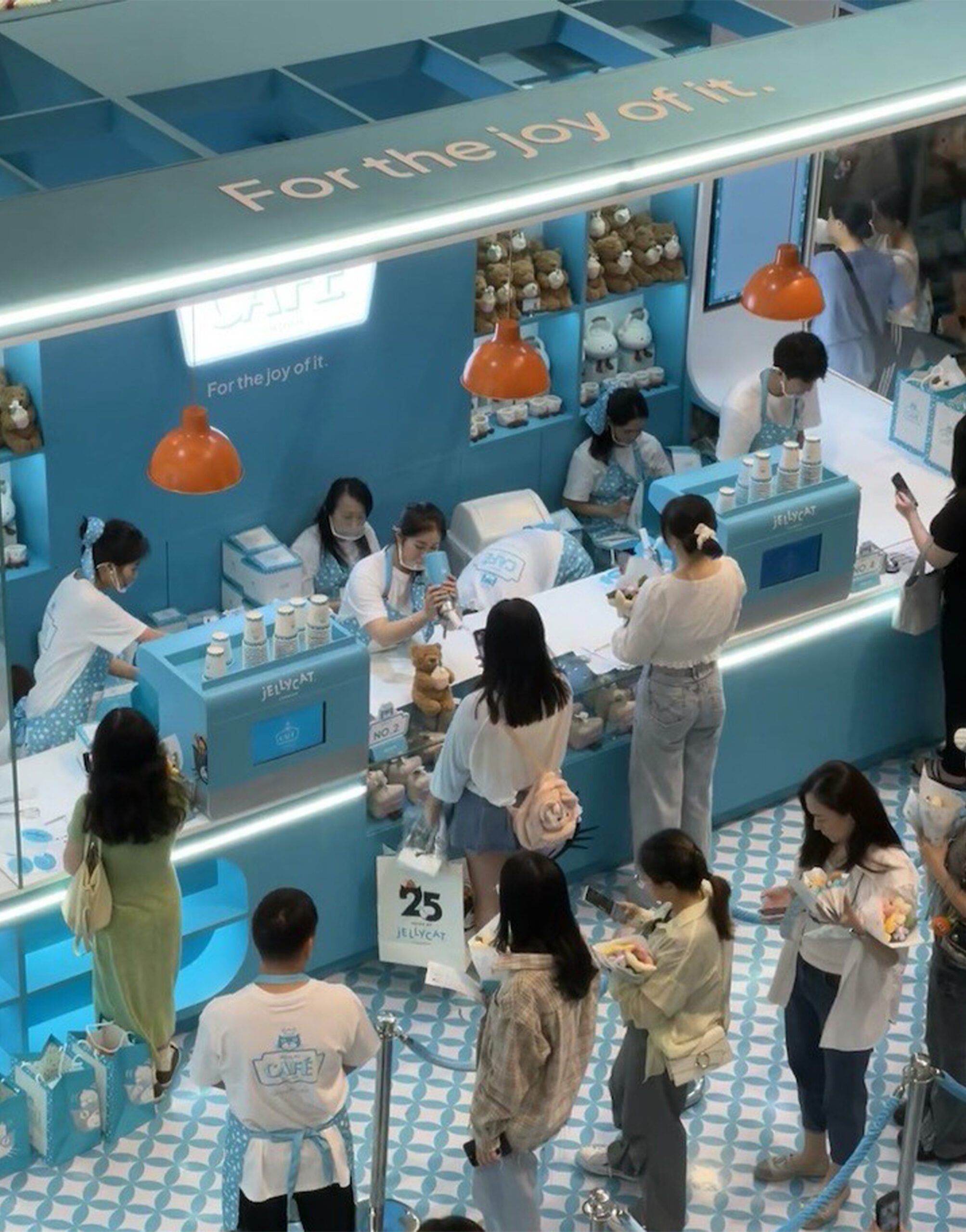
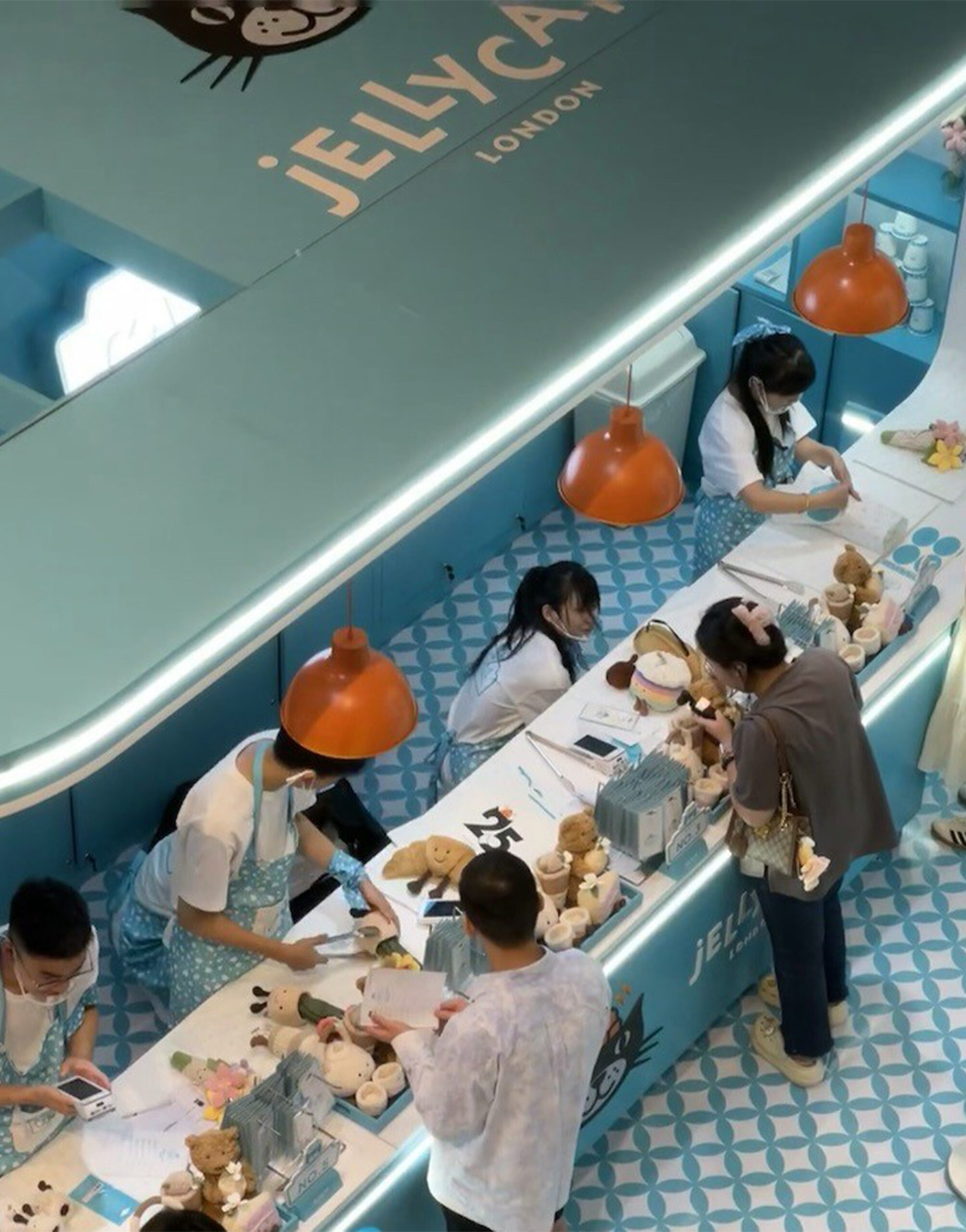
This experiential wave extends even to the most mundane elements of the retail journey. Nanjing’s Deji Plaza made headlines not for a new anchor tenant, but for its restrooms: luxuriously designed, diversely- themed artistic spaces that have become social media phenomena. What might once have been a purely functional space is now a moment of delight and surprise.
These examples point to a larger, more profound shift in the DNA of retail, especially visible in China’s emerging category of “non-standard commercial real estate.” In contrast to the rigid formats of traditional malls or department stores, these projects embrace flexibility, decentralisation, and experience-first thinking. They’re less about maximum lease efficiency and more about spatial experimentation and emotional texture. Many are built in unexpected places: under railway viaducts, inside decommissioned factories, or in the shells of forgotten podiums – spaces once dismissed as unusable are now fertile ground for urban reinvention.


“In China, the demand for ‘retailtainment’ has surged as shoppers become more discerning and frugal with their spending […] Whether through interactive installations, localised storytelling, or retail spaces that seamlessly blend with dining and lifestyle elements, the goal is to offer something that can’t be replicated online. Across China and beyond, the new standard for retail destinations isn’t just about aesthetics — it’s about creating spaces that resonate culturally, encourage social sharing, and ultimately foster lasting brand loyalty.”
Take Hai 550 in Shanghai, which transformed a gritty, industrial site into a vibrant, culture — forward retail hub. Or Aranya: a serene coastal development designed for reflection and disconnection, loved by China’s “lying flat” generation. In Central Market Hong Kong, heritage preservation fuses with food, fashion, and street performance. Meanwhile, Luxe Lakes CPI Chengdu imagines retail as part of a floating landscape, where you shop alongside water gardens and sculpture trails.
The most successful retail activations in APAC are often narrative-driven. They focus on a story, concept, or idea and translate it into an experience that not only hits traditional retail touchpoints but also feels innovative, engaging, and experiential.”
This pivot toward the experiential, the non-linear, and the unexpected isn’t just aesthetic. It’s a strategic response to shifting consumer priorities, tighter urban land constraints, and a generational demand for deeper connection. These disruptors are proving that retail doesn’t have to be a copy-paste template. It can be elastic, imaginative, and wildly expressive.
From Experience to Transformation: The Importance of Evoking Awe in Luxury’s Transformation Era
By Chris Sanderson, Co-Founder, The Future Laboratory
Since the mid 2010s, I have been observing how ‘experience’ has evolved and overtaken the traditional allure of ‘product’ as a commercial growth area – especially within the luxury sector. But experience was being designed, packaged and sold as a passive utility that could be pushed out to an audience eager for greater brand engagement, without really grappling the more profound opportunity that lay at the heart of this exchange – transformative relationships.
At The Future Laboratory, we anticipated the emergence of a trend towards a new form of engagement – a more purposeful, self-initiated and proactive desire by society to consume the goods, products, brands and services which enabled them to be happier, healthier and wealthier.
We called this the Transformation Era back in 2018 and since then, The Future Laboratory has developed its thinking on the power of transformational engagement, taking into account evolving generational mindsets around what we have termed ‘neo-collectivism’ – the desire to put a sense of society above a sense of self. The Ancient Greeks identified this as Eudaimonia, the notion that pleasure and contentment come from the flourishing of a society that puts communal wellbeing over self — focussed, sensual satisfaction (hedonism).
Throw in the increased interest and empirical data on proprioception (awareness of body position) and we have a journey of transformation that relates to a sense of scale, awe and wonder – all vital parts in an odyssey of personal growth and development. Awe plays a significant role in the continued value of the world of luxury.
Awe is a basic state of consciousness. Ordinary things can bring us awe, as well as those big tickets moments when we encounter the grandness of the natural world or the brilliant complexity of human endeavour.
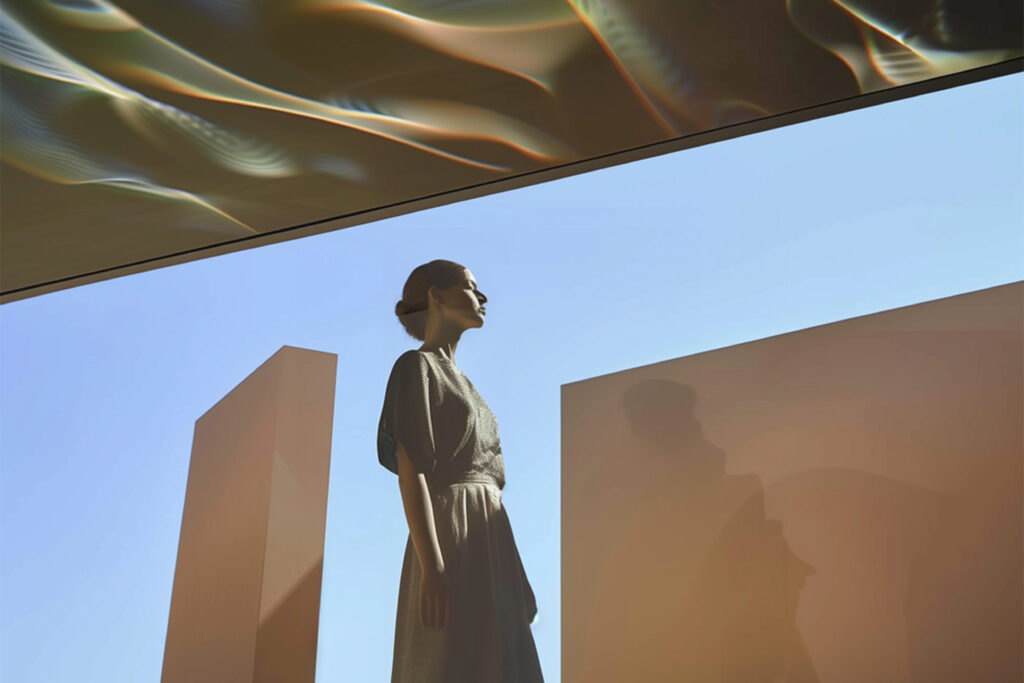
Dacher Keltner, faculty director of the Greater Good Science Center, USA, based at Berkeley, espouses, ‘My hope is that we can better embrace the mindsets of awe – from the vastness of experience to awe in the everyday’.
Luxury is awesome. The transcendence of the everyday functional object into a work of wonder – through its artistry, complexity, beauty and craftsmanship – sits at the heart of traditional luxury. Yet, as we move into a new state of luxury which perceptibly eschews these traditional markers, awe becomes more relevant than ever.
The awe pivots to the wonder of time, and the wonder of self – how awe, according to Keltner, makes you feel ‘small, humble and connected’. Awe helps luxury make the transition from a passive engagement with objets de luxe to a new transformational engagement with ourselves, through the luxury of time.
This is where the future of the luxury industry lies. I’m hoping you’re now joining up the dots. When we think of spatial, or intentional design, we naturally tend to migrate to the awe — inspiring being those grandiose, large — scale spaces that evoke awe simply by dint of their size. And yet, with the concept of proprioception in mind, how we are moved to feel elevated by the humble, small, every — day and mundane space is perhaps a greater challenge that we as designers, architects and creatives must face in the future.
Retail as the Phygital Frontier
As the boundaries between physical and digital continue to dissolve, the next era of retail is being shaped not just by aesthetics or convenience, but by interaction — intelligent, immersive, and intuitive. Retail is evolving into a phygital frontier, where in-store experiences are enriched with digital enhancements, and online environments strive to capture the tactility and emotion of real life.
Brands around the world are investing in emerging technologies — from AR mirrors to AI — powered stylists, from smart shelving that tracks inventory in real time to VR pods that plunge shoppers into alternate realities. These tools aren’t gimmicks; they’re part of a broader strategy to personalise shopping journeys, boost operational efficiency, and rewire the emotional connection between people and products.
The data speaks: recent studies show that a growing number of Gen Z and Millennial consumers expect some form of augmented experience when shopping in-store. In China, smart retail applications are already becoming normalised, with brands like Alibaba and JD.com leading a phygital retail revolution.
Base: Gen Z 1,000, Millennials 1,000, Gen X 1,000, Baby boomers 1,000
Source: PwC Holiday Outlook 2024
Reflexive Retail: AI and the Omni-channel Dreamscape
By Katie Baron, Content Director, Stylus: The trends intelligence business
AI will reinvigorate physical brand environments in ways that will supercharge the omni-channel retail experience while also creating more compelling lines of connections to more fantastical brand’s narratives – those subtle suspensions of disbelief that enable people to step or relax into alternative worlds, and potentially brand manifestos. The crux of both angles (think: help me vs. entertain me) will be experiences that are inherently more visitor-reflexive, and relevant to that moment because of their far more advanced connection to real-time information beyond the brand itself.
On the pragmatic-meets-inspiration side, consider Sephora’s flagship in Shanghai which includes Care and Look Analysis devices which draw on skin diagnostics, styling trends and its real-time inventory (only what’s in-store) alongside using XR tech to offer up recommendations and tutorials. I also anticipate phygital discovery concepts using ‘speak it to dream it’ tech of the kind we saw at Miami Art Week in 2024 where people will be able to converse with the environment itself to visualise what they want – desires the brand will then be able to respond to with relevant suggestions.

One of the most intriguing examples of this hybrid future is Future Stores, an initiative that explores what retail could become when storytelling, tech, and environment merge seamlessly. From holographic campaigns to AI-assisted consultations, Future Stores offer a dynamic stage for brands to experiment with what’s next. Conversations with its founders reveal a shared belief: the future of retail isn’t about replacing the physical — it’s about enhancing it with digital layers that respond, adapt, and inspire.

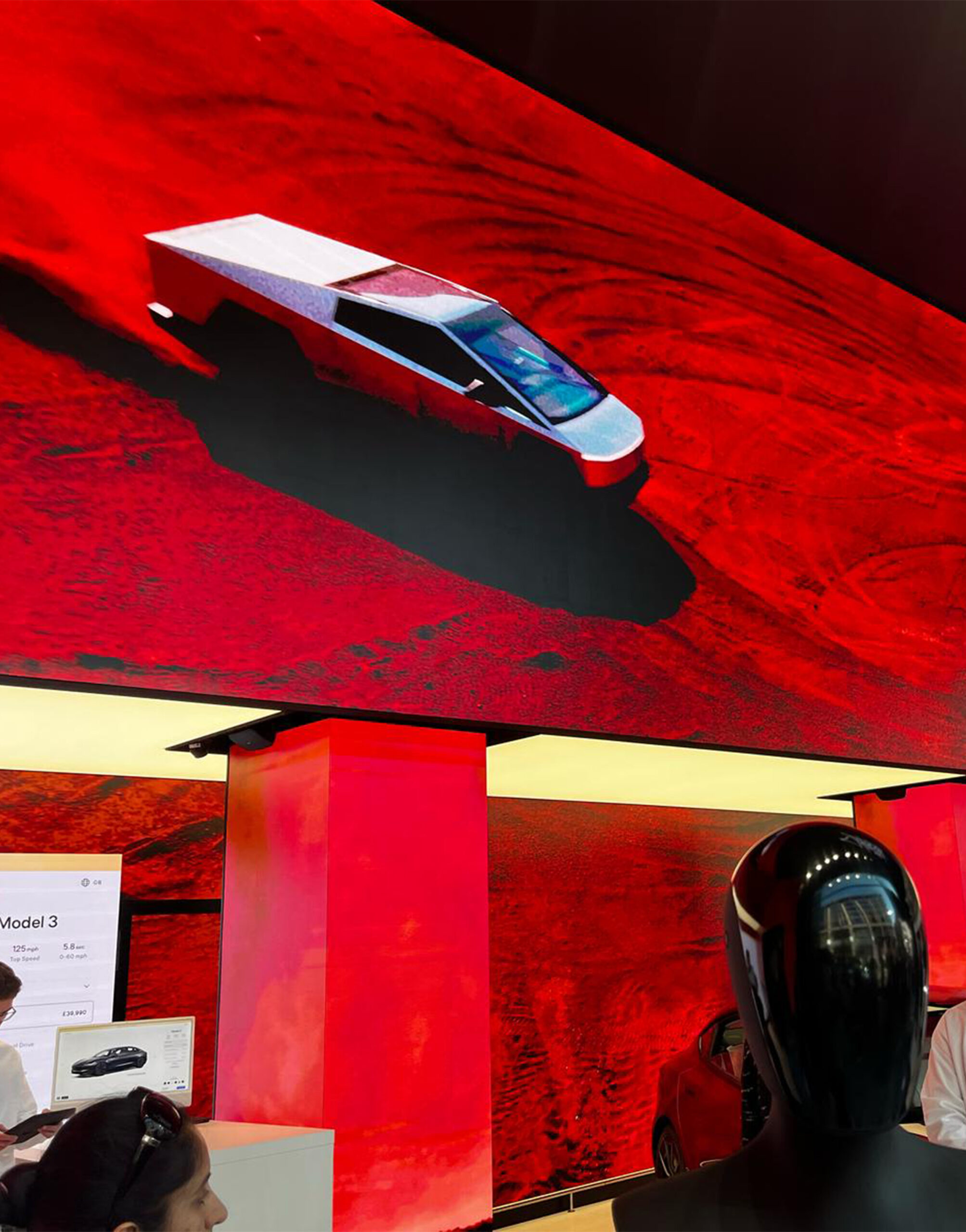
Another standout example is xydrobe at Harrods, a plugin immersive VR cinema that redefines what a brand installation can be. Created in partnership with Sybarite and luxury watchmaker Vacheron Constantin, this cinematic pod places viewers inside a fully sensorial narrative experience — from scent to sound to temperature — all synchronised to a visual storyline that deepens brand engagement. It’s a next-gen take on experiential marketing, merging spatial design with virtual storytelling in a way that feels intimate and cinematic rather than cold or clinical.
Meanwhile, Nike’s House of Innovation continues to lead with its tech-enabled flagship stores around the globe. These aren’t just spaces to buy sneakers — they’re labs where visitors interact with products in constantly evolving ways. From smart fitting rooms to app-linked customisation zones, every touchpoint is curated to feel personal, responsive, and innovative. Nike’s integration of data, design, and community programming positions the brand as a leader in shaping phygital ecosystems.
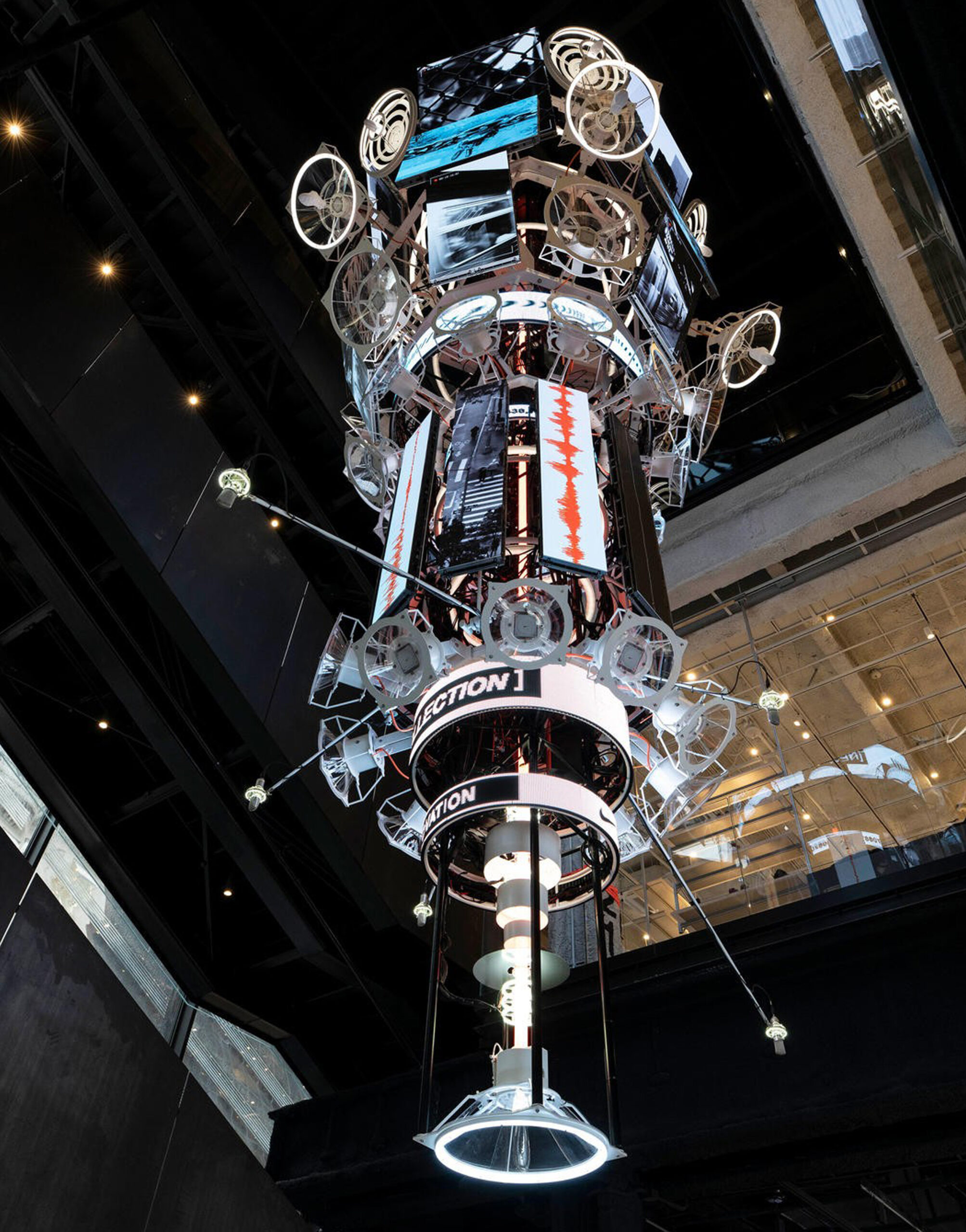

Designer Feng Chen Wang is also pushing this frontier, not only through her own collections but also in collaboration with brands like Nike and via AR — enhanced activations like those seen at ComplexCon Hong Kong. Her work imagines a future that is both inclusive and technologically expressive — merging the tactile craft of fashion with digital extensions that offer personalisation, accessibility, and surprise.
“As the technology becomes increasingly more sophisticated, lighting, scent, and ambiance based on mood, demographics, and even cultural context will morph and adapt […] This participatory and personalised approach will create a space where the customer feels engaged and valued at every touchpoint.”
In this phygital paradigm, emotion is again the ultimate currency. Whether it’s the thrill of stepping into a VR dreamscape at Harrods, the precision of a virtual sneaker fitting at Nike, or the playful shock of an AR pop-up in Hong Kong, retail is no longer just about what you buy. It’s about how you feel while buying it.
The future store isn’t a fixed destination: it’s a fluid, reactive platform where technology enhances intimacy, not replaces it. The most successful phygital retailers will be those who use digital tools to make physical presence more meaningful, more memorable, and more human.
Retail as Catalyst: Shaping the Cities of Tomorrow
As cities evolve and reimagine their purpose, retail is no longer just a backdrop to urban life. It has the opportunity to become a key force in shaping the very structure of tomorrow’s metropolises. Once viewed primarily as a commercial function, retail today has become a multidimensional catalyst: sparking community, revitalising underutilised land, anchoring new districts, and combining environmental ambitions with economic vitality.
In Chengdu, SKP Park exemplifies this shift in profound and architectural terms. Sited within the city’s 16,900-kilometre Tianfu Avenue Green Belt, the project was met with a clear constraint: no buildings could rise above ground level. Rather than see this as a barrier, SKP and Sybarite transformed it into a bold design opportunity. The result is a sunken retail world, carved into 190 acres of landscape, one of the largest below-ground retail environments in the world. Above it lies a sweeping, uninterrupted park gifted to the people of Chengdu. This parkland is not ornamental; it reflects SKP’s commitment to green urbanism, contributing to China’s broader ambitions for carbon neutrality and sustainable urban growth.
What’s remarkable is that the commercial experience remains uncompromised. Over half a million square meters of mixed-use programming, housing more than 1,300 of the world’s top luxury and lifestyle brands, exist seamlessly within the subterranean structure. The design strategy resonates with the philosophy of “landscape urbanism,” prioritising spatial atmosphere, biodiversity, and topographical flow over the more common reliance on isolated, image-driven architecture.
SKP Chengdu also serves as a socio-economic anchor. It is a gravitational point for culture, commerce, and community, redefining how Chinese cities can grow more inclusively and resiliently. By integrating cultural installations, hospitality, art, and advanced retail technologies, it signals a future where urban centres are designed to be flexible ecosystems, rather than fixed commercial zones.
“Historically, Western brands have also underestimated the importance of ‘third spaces’ in China. In the West, a lot of our retail stores are sterile, and retail is seen as purely transactional […] But Chinese consumers have always expected a level of ‘retailtainment’ that goes beyond just browsing products, and those standards are only heightening. With the stakes raised, shoppers want a more holistic approach to brand engagement, filtering out those who are simply in it for the money from those genuinely invested in creating meaningful experiences.”
Across the globe, similar dynamics are unfolding in innovative ways. In London, Coal Drops Yard transforms the Victorian industrial past into a contemporary social landmark. Originally built in the 1850s as coal warehouses, the site had fallen into decline before being reinvigorated through a visionary adaptive reuse strategy. Rather than demolish its history, designers integrated contemporary forms into the existing infrastructure, creating a blend of heritage and innovation.
Coal Drops Yard actively invites civic participation. Beyond hosting independent boutiques and chef-led restaurants, it provides platforms for local makers, cultural events, and public programmes. Its success lies not only in its foot traffic but in how it fosters a renewed sense of ownership and identity among Londoners. It’s retail as public space, not just private enterprise.
Meanwhile, in the Middle East, retail is central to the visioning of future cities, especially under Saudi Vision 2030. As the kingdom looks beyond oil dependency, mixed-use megaprojects such as Diriyah Gate and NEOM are putting retail at the heart of their masterplans. These aren’t just shopping centres; they’re fully integrated ecosystems designed to attract tourism, support cultural exchange, and stimulate economic diversification. Retail here plays a dual role: enabling global connectivity while preserving local heritage.
“Vision 2030 is more than a national development strategy – it is a cultural reset […] The kingdom is positioning itself not only as an economic powerhouse but as a global laboratory for new forms of urban expression. Cities like Riyadh are rapidly transforming into experience-driven environments where authenticity and ambition go hand in hand. At Diriyah Gate, we drew on Najdi architectural language not as nostalgic reference but as a framework for contemporary storytelling — reinterpreting heritage as an engine for innovation. Over 70% of the kingdom’s population is under 35, a generation that has grown up connected, mobile, and globally attuned. Their expectations are multidimensional. They seek depth and identity, but also fluidity and access. They value spaces that are immersive and expressive, where boundaries between living, learning, working, and playing are blurred.”
Taken together, SKP-S, Coal Drops Yard and Saudi Vision 2030 point to an emerging truth: retail has become a mechanism for urban storytelling and ecological regeneration. It is not just a reflection of consumption, but a generator of culture, connectivity, and progress.
“The cities of tomorrow won’t compete on size, spectacle, or scale. They’ll compete on resonance — on the capacity of a space to be remembered, revisited, and recommended. For architects, this is a design opportunity. For developers, it’s a business imperative.”

The Future of Experience
The Sybarite Report 2025/26
"*" indicates required fields

